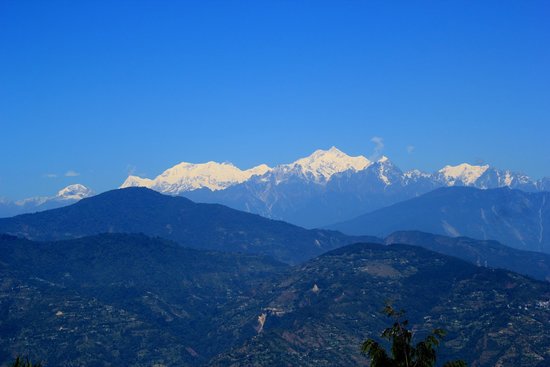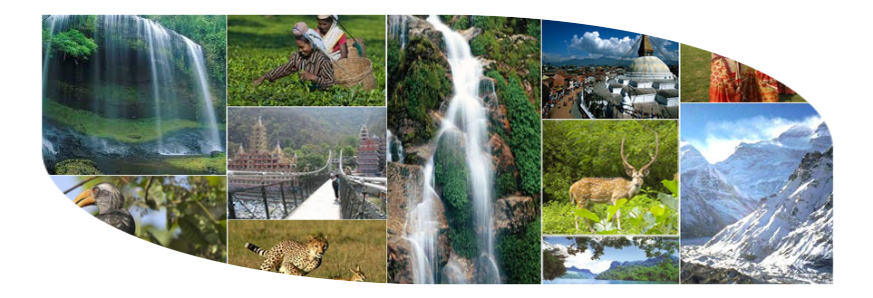
It is one of the more comfortable cities in this region—and visitors on a hectic trip to this side of the country will probably be drawn in by the handful of Tibetan structures, and the comfortable hotels; but the relaxed atmosphere, the local culture and the amazing food is what will keep them exploring the streets of the city for more days than they had planned.
Located on what used to be a busy trade route into Tibet, this is a fascinating place, defined as much by its mixed population of Tibetans, Lepchas, Bhutias and Nepalis, as by the reputation it enjoys of being both the most developed city in the North East, as well as the most mired in problems associated with urban sprawl. But venture further enough into the lanes and the upper parts of the town, and you will be rewarded with glimpse of the few traditional houses, as well as awe-inspiring views of the Khangchendzongamountain.
Gangtok , on a fresh April or October morning , is bright and cheery. Impeccably dressed women go off to work , monks hurry down the bazaar, young men amble along and tourists can be seen sampling the delectable food on the offer. On clear days, the tall mountain peak of Khangchendzonga can be seen from hotel windos. Although Gangtok doesn’t have the quaint colonial charm that Darjeeling exudes, the relaxed atmosphere and the mix of the traditional and the modern are definitely worth the trip.
As you leave Siliguri and head towards Gangtok, watch out for the beautiful Teestariver on the left and the inventive anti-speeding road signs all over.
Gangtok offers many ‘sightseeing ‘spots such as Ganesh Tok, Hanuman Tok and TashiViewPoint, but truly enjoy the town, simply walk around. On a good day after monsoons , you can see Khangchendzonga and the rest of the range in all its majestic glory. The view of the peaks change colour through the day, owing to the Sun’s rays.
The town’s best shopping areas are the Main Market on the pedestrian-friendly MG Marg, and the local produce bazaar in the Khangchendzonga Shopping Complex.
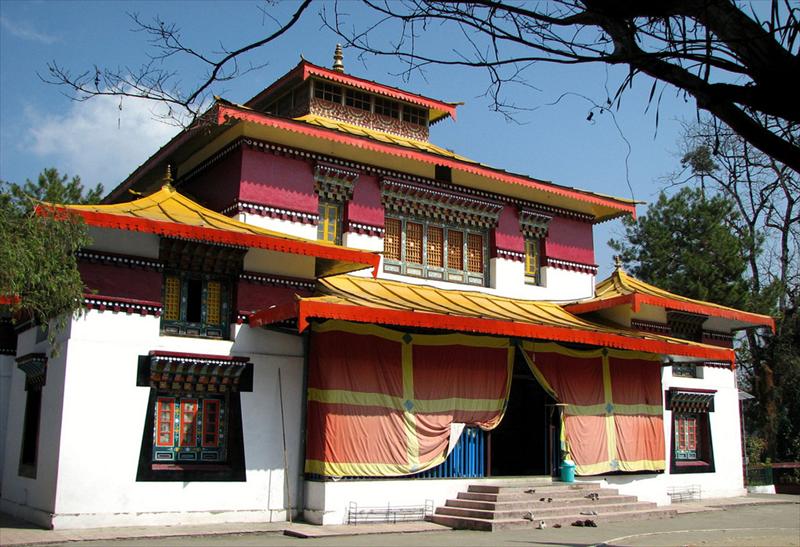
This monastery is located above the Ridge and shouldn’t take more than fifteen minutes if you decide to walk it. “Enchey” literally means the ‘ high, strong place” ,and it lives up to its name, perched on the upper slopes of the town.
The Monastery was build in the middle of the 19th century on a site that was said to have been blessed by the Trantic master DruptobKarpo. Traditionally built in the Tibetan style , its charming and vividly painted porch holds murals of protective deities. The place came alive in December / January when the vibrant ,unmissableDetorChaam masked dances are performed here.
Spend a morning here listening to the hypnotic chants of the monks during prayers . Locals often stop by to pray before going to work.
Timings—4am to 4 pm ( Monday to Saturday ) and 4am to 1pm ( Sunday )
The mueum within the NamgyalInstitute is a must visit place. Situated in the lower part of Gangtok, in Deorali, the museum includes a stunning collection of ancient statues and artifacts in a building that is equally impressive. Established in the 1958, this institute holds one of the largest collections of Tibetan works in the world outside of Tibet.
The museum exhibits a rare collection of ancient manuscripts dating back to the 11th century, statues, ritual objects and “thangkas”( paintings) . The display is dominated by a majestic silver image of Manjushri, the Boddhisattva of knowledge, brought from Tibet. The place is well organized and has helpful captions explaining the displays.
Entry –Rs.10/ . Timings--- 10 am to 4 pm.
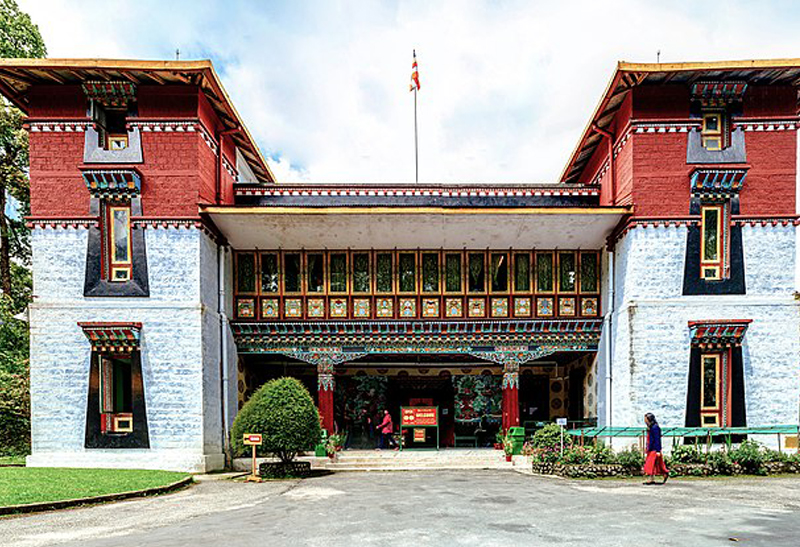
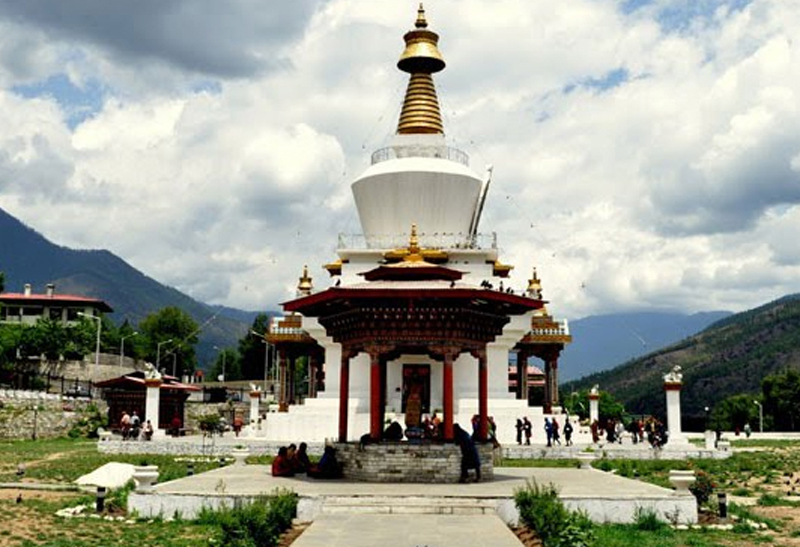
If you walk past the Namgyal Institute along the same road , you will reach a significantly steep pedestrian path which leads to the Do-DrulChorten. This is a huge , gleaming-white pagoda, with prayer wheels all around, and surrounded by dormitories for young monks in training and butterlamp galleries that you can peer into through the huge glass walls.
The chorten itself is capped by a gilded tower , the rising steps if which are meant to signify the 13 steps to attain nirvana.
Behind the chorten and monastic complex is a prayer hall housing a large image of Guru Rinpoche. A curious feature of this statue is the fact that the head of image projects into the ceiling. It is kept protected by a raised section of the roof built especially to accommodate this extended part of the statue. It is believed that it is so because the statue is still growing.
The Gangtok Zoo – more formally known as the Himalayan Zoological Park ---is a beautiful lush hillside treasure of wild flowers and misty views. Located right next to Ganesh Tok, this open zoo is spread across 205 hectares of mountainous terrain and is a great place to visit for long walks and the chance to spot rare animals.
The animals are kept in conditions relatively close to their natural habitats –the enclosures are large open spaces---and are far better off than their counterparts in other Indian zoos. Look out for the snow leopard , Tibetan wolves , some adorable red pandas, Himalayan palm civets, leopard cats, and several species of colourful Himalayan pheasants.
Entry—Rs.25/ . Timings—9am to 4 pm. Thursday closed. Vehicle entry Rs.40/ . Videography –Rs.400/
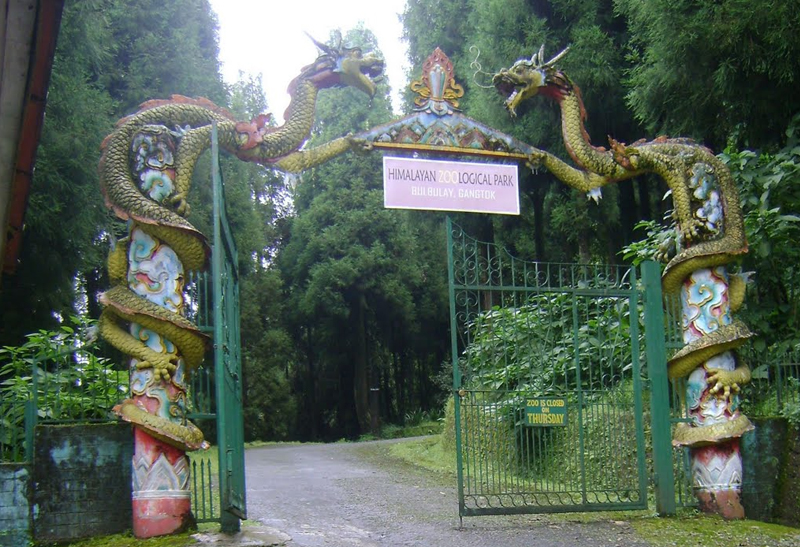
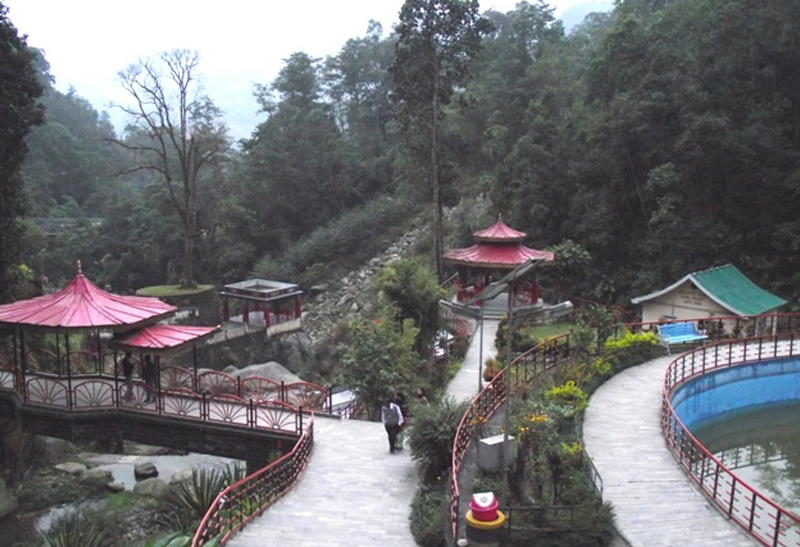
Located just outside of Gangtok near Sicheygaon , this is abuzz with families , of both the local and tourist varieties, at all times . Well-organized and maintained, the park is a bit of a tourist gimmick with some mildly problematic “shamanistic” statues, but can nevertheless be a great respite for parents with kids who are just looking to burn off some energy.
Entry—Rs.50/ .Timing –9am to 5 pm. Photography Rs.30/ . Parking Rs.20/
Located on the North Sikkim highway , 6km away from Gangtok . This place offers a excellent view of the mountain Kanchenzongha snowy range. On the opposite hill , the Phodong and Lavrang mountains can be seen. Ideal time to visit is in the morning.
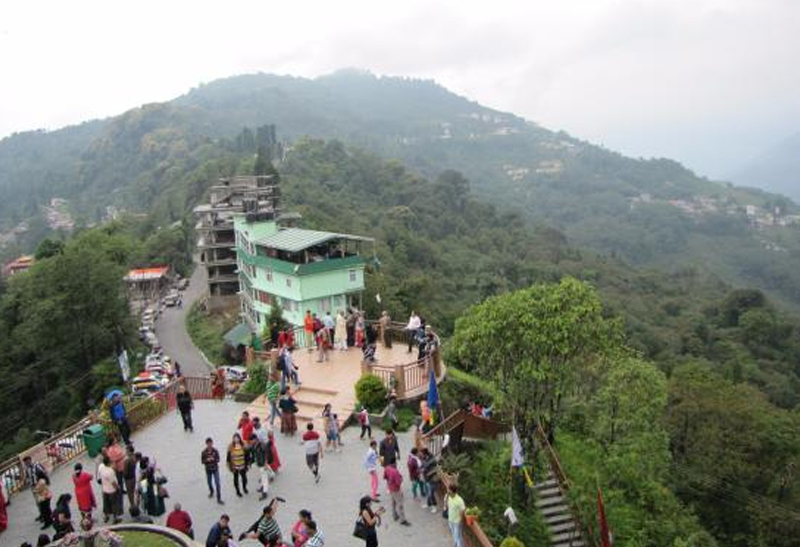
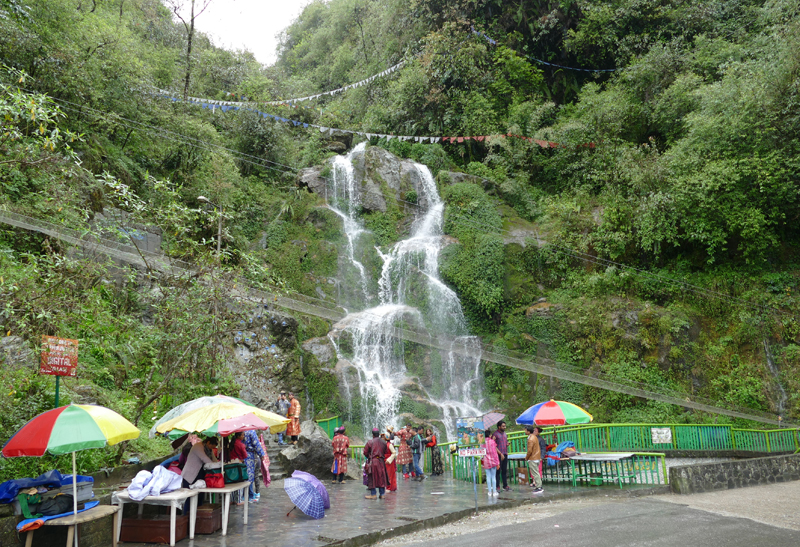
Located on the North Sikkim highway , 6km away from Gangtok . This place offers a excellent view of the mountain Kanchenzongha snowy range. On the opposite hill , the Phodong and Lavrang mountains can be seen. Ideal time to visit is in the morning.
The Ridge is small stretch of plain and flat road above the town of Gangtok. The ridge has the White Hall and the Chief Minister’s official residence , known as the Mintogang , meaning ‘ blossomed crowned hilltop’. The white hall has the historical value and is situated on the Ridge. It was built in 1932 and is a two storied structure and has typical British architecture.
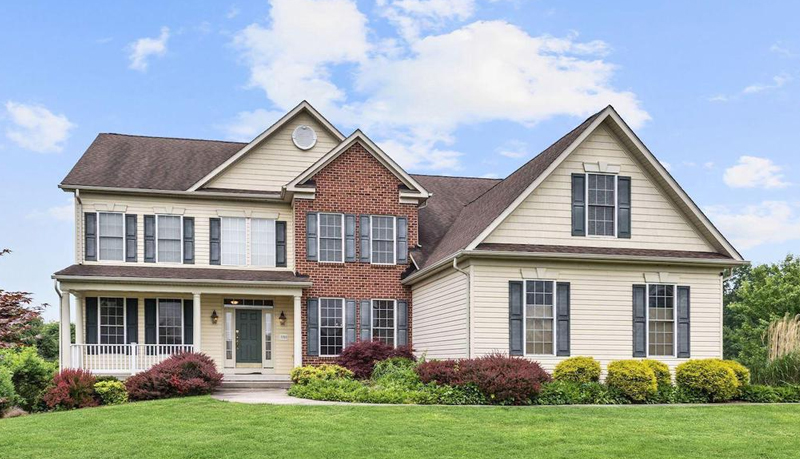
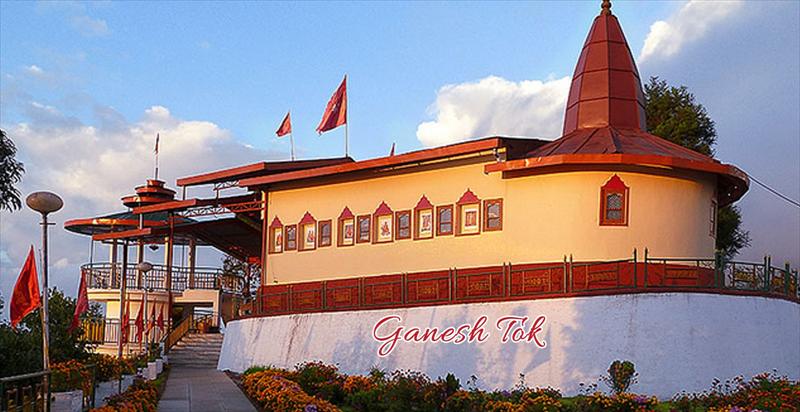
It is situated 7 km away from Gangtok , is a small temple name Ganesh Tok. It is one of the hill top at an altitude 6500ft . A panoramic view of Gangtok town and Raj Bhawan Complex can be obtained from here.
It is 11km from Gangtok town, above Ganesh Tok with a Hindu Temple where devotees come and offer prayers. Because of its location advantage the view of the mountains along the horizon is just magnificent especially on a clear sunny morning.
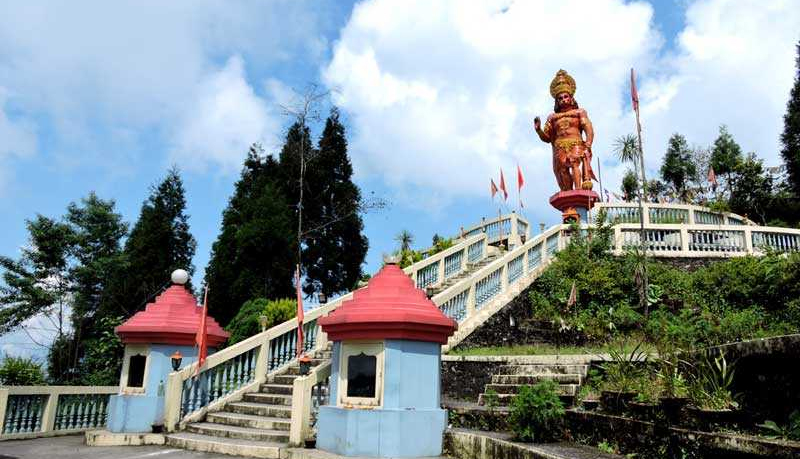
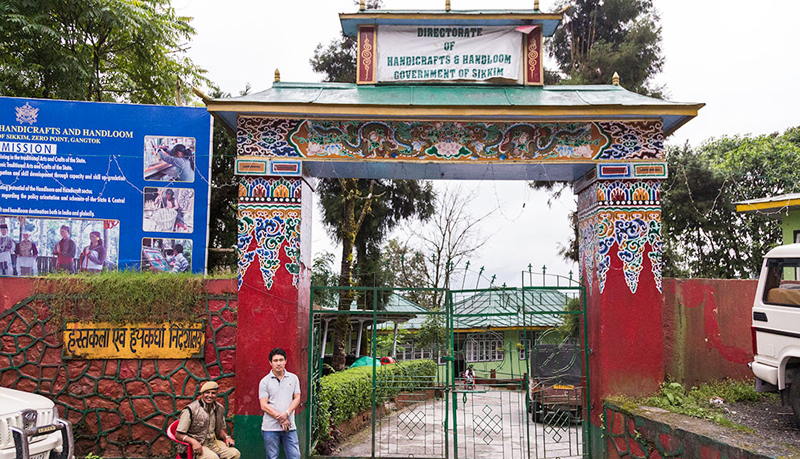
Instituted with the aim of promoting and keeping alive the State’s traditional arts and crafts, the Directorate of Handicrafts and Handloom is a storehouse of hand woven woolen carpets with traditional motifs, blankets, shawls in Lepcha weaves and exquisitely carved ‘ choktse’ or table and many other gift items.
Visiting time—9:30 am to 12:30 pm and 1 pm to 3 pm .( Sunday closed )
This institute is located at about a kilometer uphill from the main market of Gangtok. In 1957 it was established, with the purpose of promoting manufacture and sale of local carpets, handicrafts, and furniture. Handmade paper is another unique novelty of the Institute and is made from the bank of tree Argali. The paper is used extensively for invitation cards and letter pads.
Time—10 am to 4 pm ( Sunday&Govt.Holidays are closed )
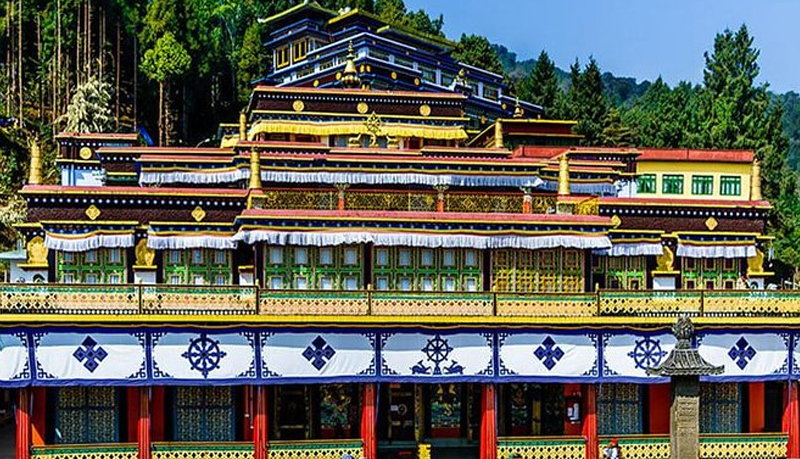
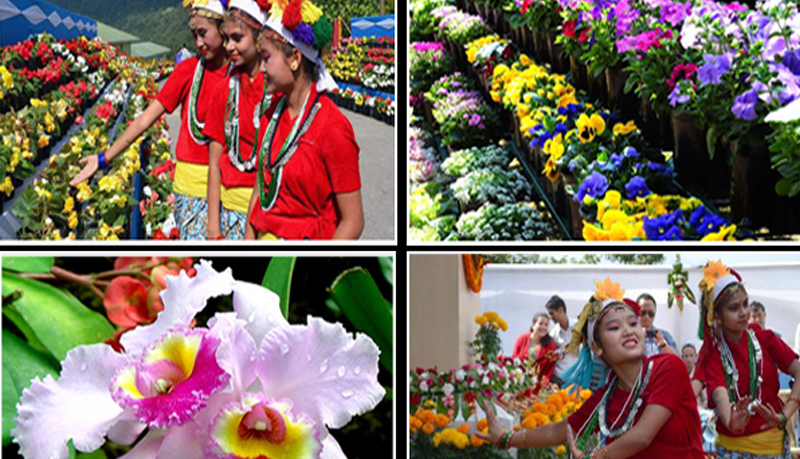
Flower exhibitions are organized around the year at the Flower Show Venue near the White Memorial Hall Complex, Gangtok. Orchid shows held during the spring tourist season is one of the most popular shows organized in the State.
Location of Rumtek Monastery is located 23 km east of Gangtok. Rumtek&Lingdum monasteries are two of the most popular day trips from Gangtok, the former perhaps markedly more than the latter. However , both are essential must dos for the perfect introduction to the rest of Sikkim, away from the urban sprawl of the capital city.
RumtekMonastery , also called the Dhrmachakra Centre , is located in the small hamlet of Rumtek, that has pretty much come up around the monastery. The walled complex houses and the main prayer hall, several religious buildings, schools and even some lodges and hotels for tourists who want to spend a quiet night away from the hubbub of Gangtok.
The monastery here was built as a replacement for the Tsurphu Monastery in Tibet, which had been partly destroyed during China’s “ Cultural Revolution “ in the 1960s. You can see a painting of the original monastery as you enter the Rumtek compound. The most unusual feature of the monastery is the fact that it is manned and guarded by army personnel. The Kagyu sect, or ‘Black Hat” sect, derives its name from a seemingly priceless black hat that is traditionally worn by the Karmapa, or leader, of the sect.
Upon the death of the 16th Karmapa, RangjungRigpeDorje, in 1981, a bitter feud began within the sect over two candidates, both of whom were presented as a legitimate heir of the Karmapa title. Both in fact have been separately enthroned as the 17th Karmapa, and perform ceremonial duties accordingly, but have never met. Until the dispute is settled, the black hat, apparently woven from the hair of angels, is kept locked in a box and secured by the aforementioned army personnel , so as to prevent it from flying back to the heavens.
A giant throne sits empty inside the main hall of the monastery , awaiting the 17th Karmapa, if one is finally narrowed down upon.
Entry—Rs.10/ . Time—6 am to 6 pm.
Note that past the parking lot is a steep uphill slope that you will have to walk up to get to the entrance of the monastery.
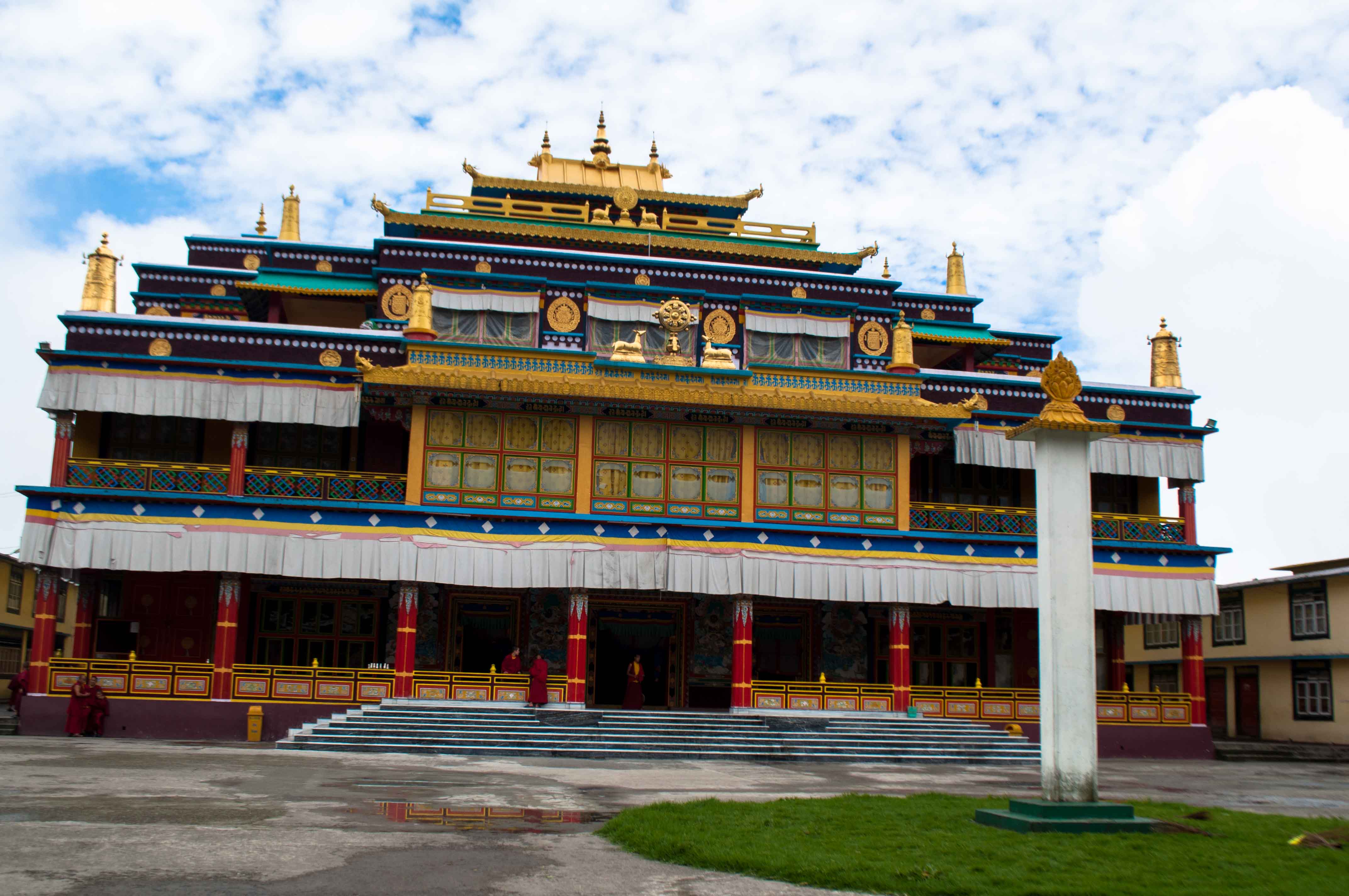
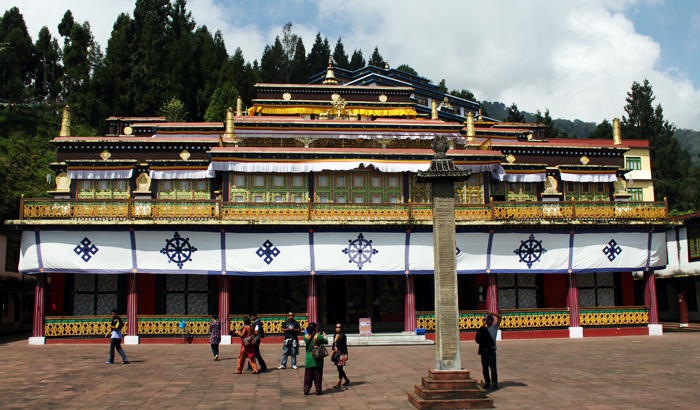
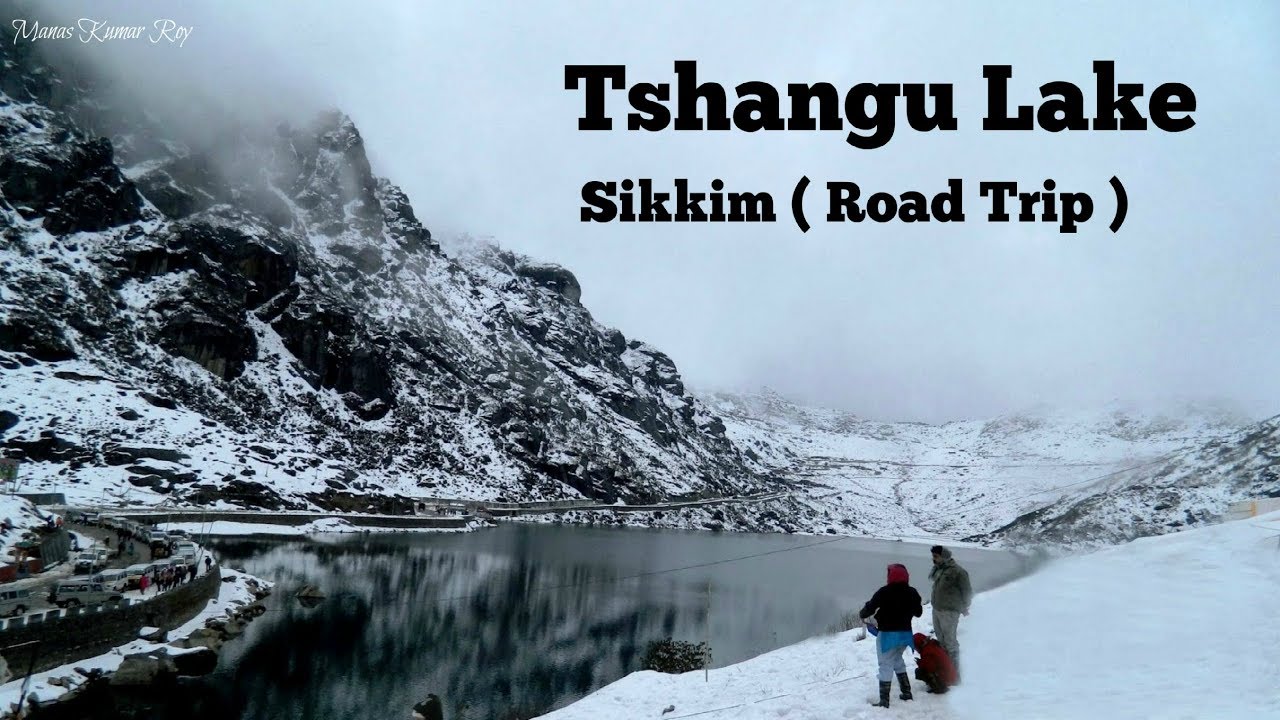
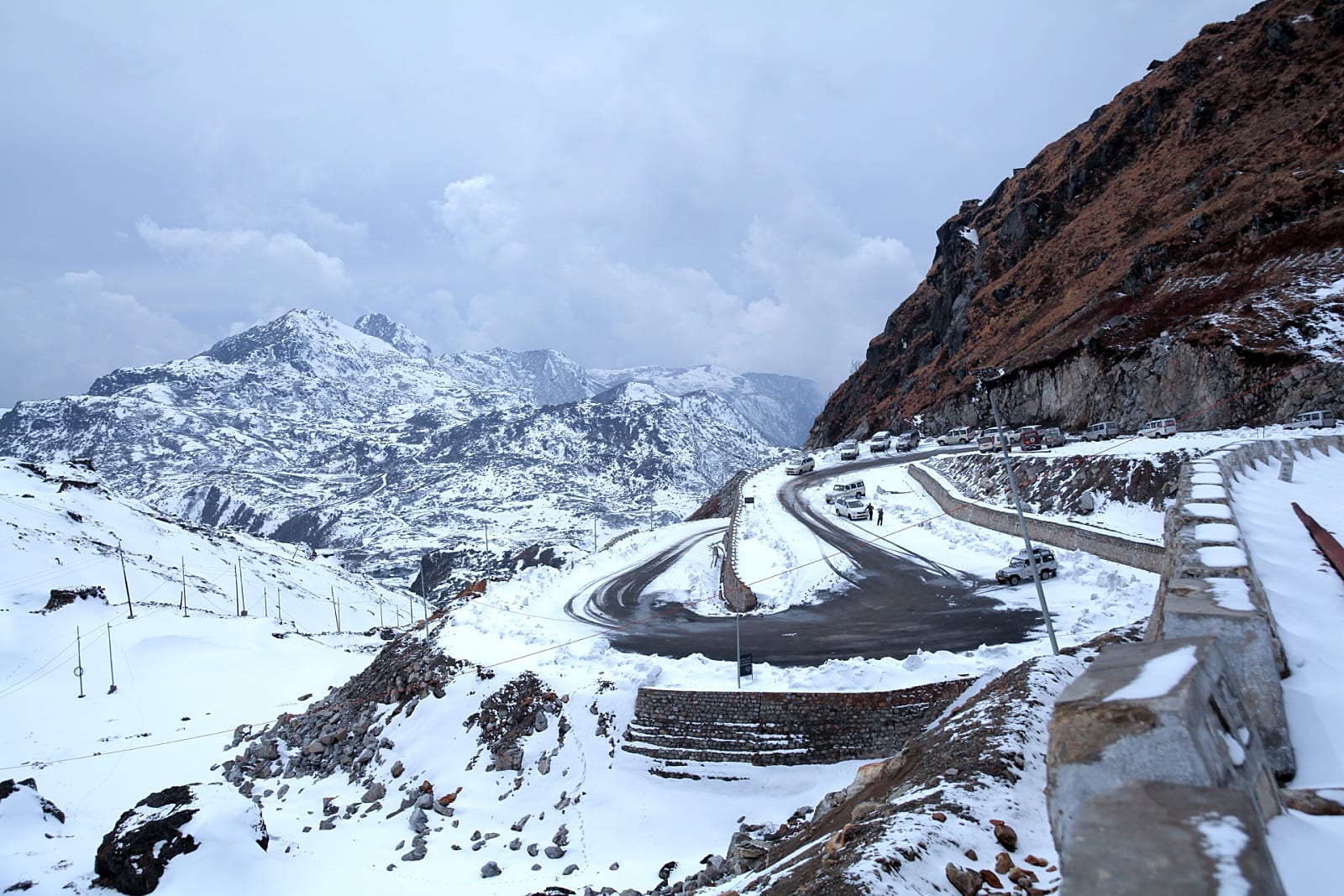
Visiting Tasngu Lake & Nathula is unlike any experience in India. You will have to apply several days in advance through your hotel or a travels agent , get up at the crack of dawn, get in a long line of cars , and slowly inch your way past the checkpost, all before 10 am, because after that no cars are allowed to head that way. Private vehicles are not permitted to go to Nathu La. Foreign tourists are unfortunately not allowed. There is a tight restriction on the number of vehicles allowed every day, so make reservations as early as possible.
Tasngu Lake literally means the “ Source of the Lake “ in Bhutia language. Just about 40 km away from Gangtok, this serene lake is situated at an altitude of 12400 feet . The lake is about 1 km long , oval in shape, 15 meters deep and is considered sacred by the local people. This placid lake remains frozen during the winter months up to mid may.
Between May and August , it is possible to see a variety of flowers in bloom including the Rhododendrons, various species of premulaes, blue and yellow poppies, iris etc. It’s also an ideal habitat of the Red Panda and various species of birds.
It’s cool, placid water is in the perfect harmony with the scenic beauty around. A small temple of Lord Shiva is constructed on the lake side. Flowers and other alpine vegetation grow wild around the lake. The lake derives its waters from melting snows of the surrounding mountains.Enroute to Tasngu lies the unique high altitude Kyongnosla Alpine Sanctuary, home of the Red Panda and the Blood Pheasant , which are the State Animal and the State Bird respectively.
It is open for both the foreign and Indian nationals. Foreign visitors have to be in a group of 2 or more and have to apply for the visitors permit through a registered Travel Agency.
56 KM from Gangtok at an altitude of 14200ft , it is one of the highest motor able roads and richly covered by many varieties of alpine flora and fauna. A tranquil place to visit just five km to the north of Jelap-la-pass, on the same altitude on a range that runs into Tibet, is the rarely used Nathu-la Pass on the Sikkim-Tibet frontier. The zig-zak track becomes steeper as it leaves Gangtok, but makes up in the changing landscape which becomes more sublime with every inch of in the changing landscape which becomes more sublime with every inch of ascent till it reaches the calm waters of the lake. From the summit , two roads, from both Jelep-la and Nathu-la passes unite in a track leading to the Chumbivally of Tibet. On the one side stands a chain of imposing peaks dividing Sikkim from Tibet.
At Nathu-la , the Chinese and Indian troops face each other almost at breathing distance. It was in the news quite a lot when skirmishes between the two countries occurred on this pass. Nathu-la and Jelep-la passes formed a part of the trade route between India and Tibet till 1962.
Open—It is open for only Indian nationals on Wednesday, Thursday s, Saturday s and Sundays. The visitors have to get the permit to visit the place .
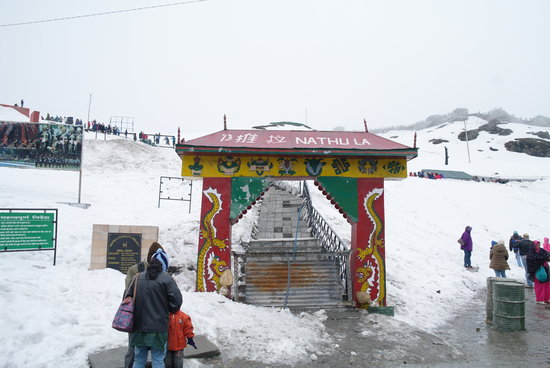
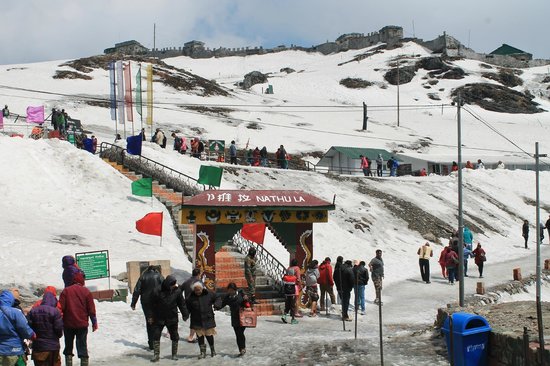
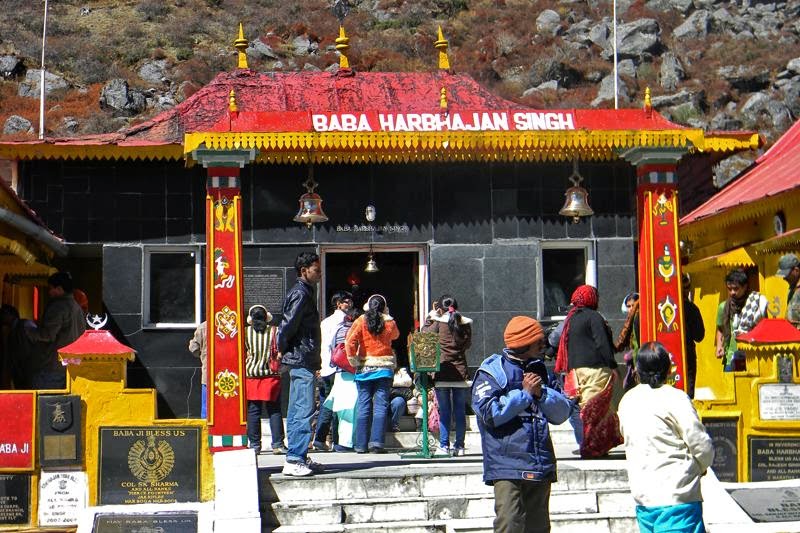
Built in the memory of Harbhajan Singh , a sepoy in the 23rd Punjab Regiment, the Baba Harbhajan Singh Mandir lies between the Nathu-la and Jepel-la passes. Legend has it that he appeared in a dream a few days after he went missing and expressed the desire that a monument be built in his memory . His fellow soldiers then built a monument that has over the years acquired the status of a pilgrimage. Believers leave a bottle of water, which they collect a few days later to take back home.
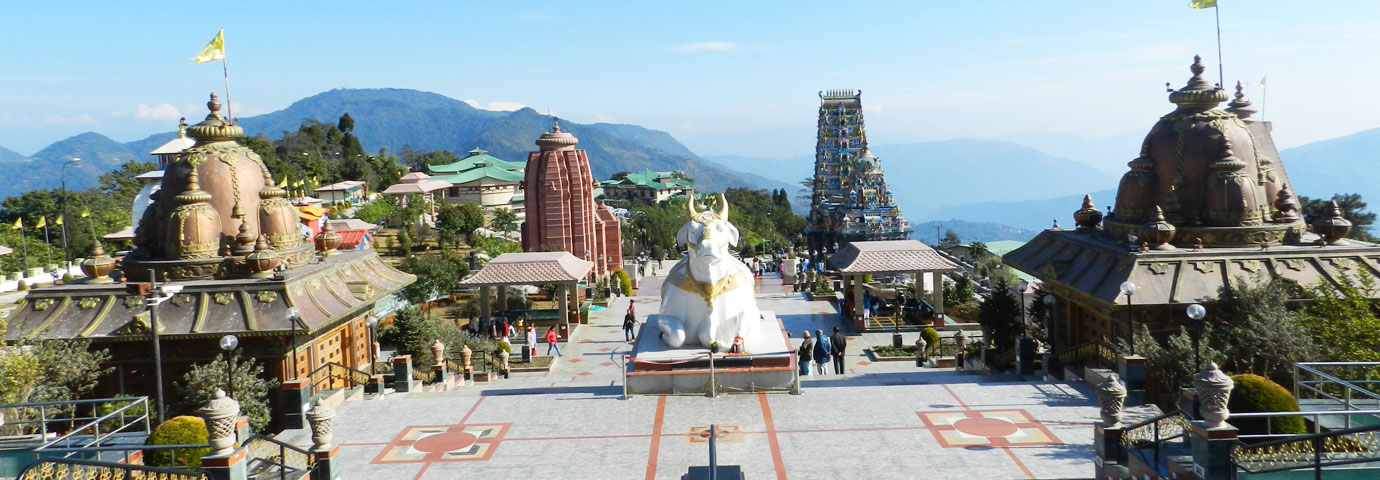
A holiday in South Sikkim guarantees views of picturesque hills and valleys, along with lush greenery, forests and fascinating monasteries.
The headquarters of the district ( South Sikkim ) , Namchi is located a mere 78 km away from Gangtok, and is a great recourse for those travelers who want to avoid the sharp twists and turns of mountain roads typical of north and west Sikkim.
The name Namchi , or ‘ sky-high’ , seems to be an overstatement, since the altitude here is no more than 5500 ft, but there are some fine views of the Khangchendzonga Range to be enjoyed. Additionally, the town hosts a flower festival in April-May, as well as the Namchi Mahostsab in the month of October –November.
The gigantic 135 ft high statue of Guru Padmasambhava towers over the forested ridge of Samdruptse , located 7 km outside of Namchi. Samdruptse literally translates to ‘ wish-fulfilling hill’ in the Bhutia language. The resplendent copper, pink and bronze image is seated on a colossal lotus plinth and faces south. The guru is shown in the NangsiZilnon form, or “ prevailing over appearances and existences”. He is seen holding a thunderbolt in his right hand, a skull in his left, and under his left armpit is the trident of the king of death.
This huge edifice is one of South Sikkim’s highlights, as much a tourist attraction as a place of spiritual importance. It was completed in 2004 and inaugurated by the Dalai Lama, and is said to have cost close to Rs.70000000/ to make. Within the complex is a hall with a permanent photo exhibition, exhibiting some what archival images from Indian history. You could take a taxi to the statue and back to Namchi, or even walk to the town, as the road that leads back passes by the 16th- century ruins of Ngadak Gompa and Fort.
Entry – Rs.10/ , Foreigners- Rs.50/. Time—All days.
Located between Namchi and Samdruptse is the Namchi Rock Garden, which houses many plants.
The Padmasambhava statue now has to complete , for tourists attention , with a massive statue of Shiva that is located within the Char Dham complex. This complex is located on the Solophok hilltop, 5km south of Namchi, and aims at constructing replicas of Hindu pilgrimage sites. There are trmples and pagodas on the hill, with the Shiva statue as the most prominent one. 4D Simulator shows ( Entry Rs.50/) are held on the premises.
On the way of to Namchi , do visit the Temi Tea Estate, located en route from Gangtok on the Tarku-Damthang road. Established in 1969 by the Sikkim Government, the 450 acre tea garden is one of its kinds in Sikkim. The Chogyal had initiated tea growing in Sikkim with a small plantation in Kewzing. From here, the plantation was moved to Temi and a proper processing plan was constructed. The garden sprawls on a gentle slope originating from Tendong Hill and is a great stopover for those looking to experience life as it was during colonial times.
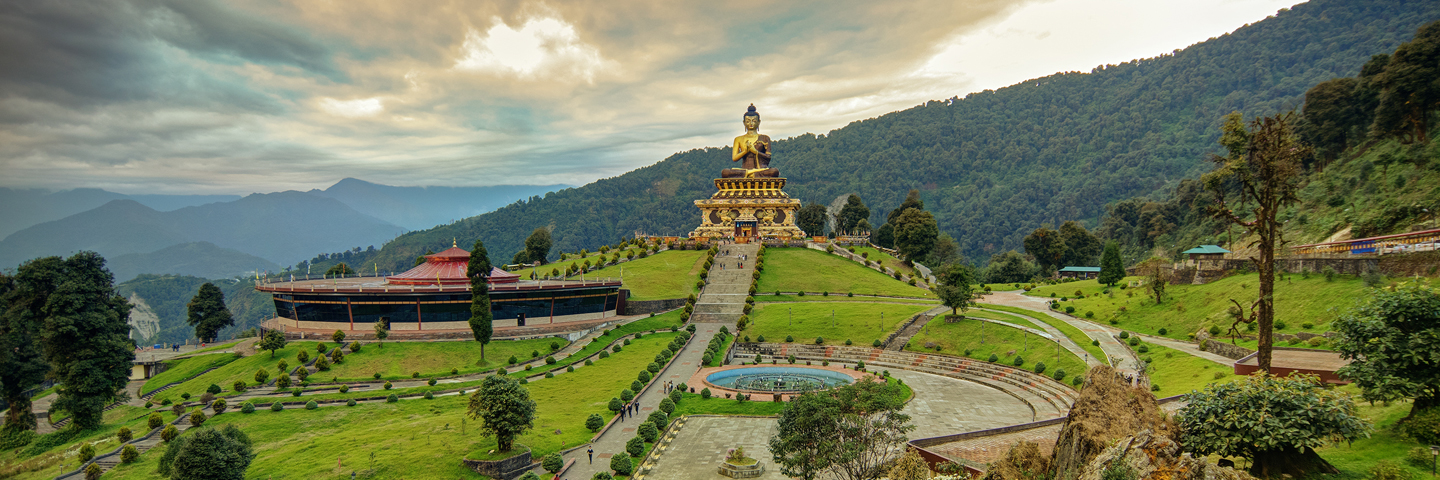
A small town in South Sikkim, surrounded by forested hills, undulating valleys, an small villages. Ravangla is a perfect destination for those who wish to catch a glimpse of Sikkimeserural life. One of Ravangla’s prime attractions is the famous New RalangGompa, which has some beautiful sculptures on its premises.
The town plays host to the Pang Lhabsol festival in Spectacular fashion every year in August or September, which is the best time to visit this place. The festivities continue in the traditional SikkimeseChaam dance on the last day.
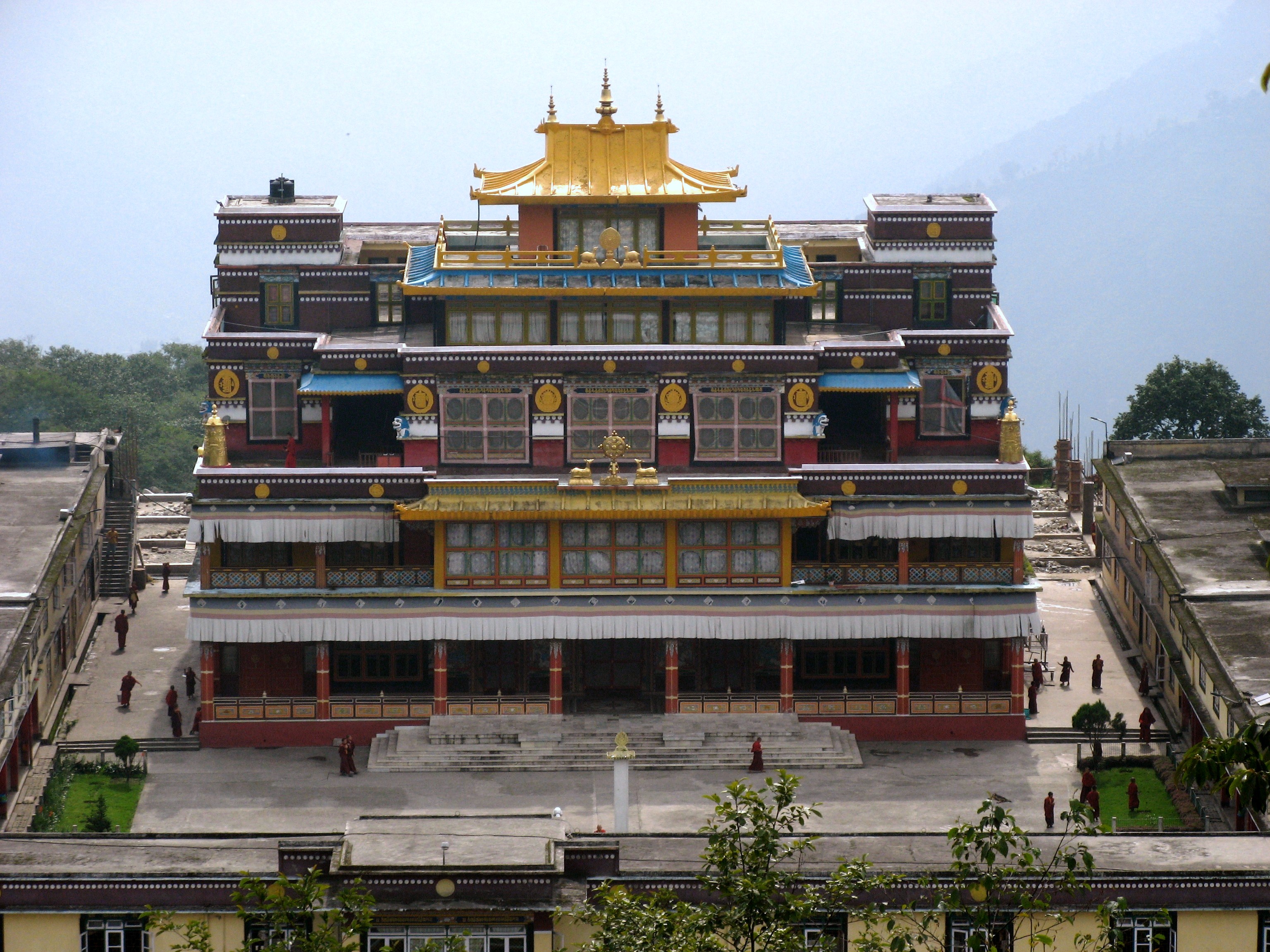
13 km below Ravangla , at Ralang, is the lovely New RalangGompa, officially known as the PalchenChoeling Monastic Institute . Set up in the mid-90s, the gompa is home to about 200 monks of the Kagyu order. Every morning and afternoon, the monks can be heard chanting in unison.
The gompa is famous for its elaborate sculptures, and inside the main hall is a 30ft statue of Sakyamuni Buddha. Every November, effigies are brought out for the Mahakaladance.
About 1.5km downhill, on the same road, is the Old RalangGompa, which is still active and more peaceful than the new gompa.
It was established in 1768, and is certainly worth a visit. The legend behind its construction goes as such; after the fourth Chogyal returned from his pilgrimage, the Karmapa performed a blessing or Rabney. During the ceremony, he threw grains from Tibet’s Tsurphu Monastery on the ground. The spot where the grains fell eventually became the site of the now famous Ralang monastery situated in South Sikkim.
The brand new Sakyamuni Complex is located at the edge of Ravangla town and is also sometimes known as the Buddha Park, probably because of the gigantic 135 ft tall statue of Buddha at the centre of the complex. The vastness of the space , and the stunning views it affords, makes for a serene spot worth a visit. The statue holds Buddhist relics donated by monasteries from all over the world, and the complex includes a meditation centre as well as a rest house for pilgrims.
Entry : Rs.50/ per head.
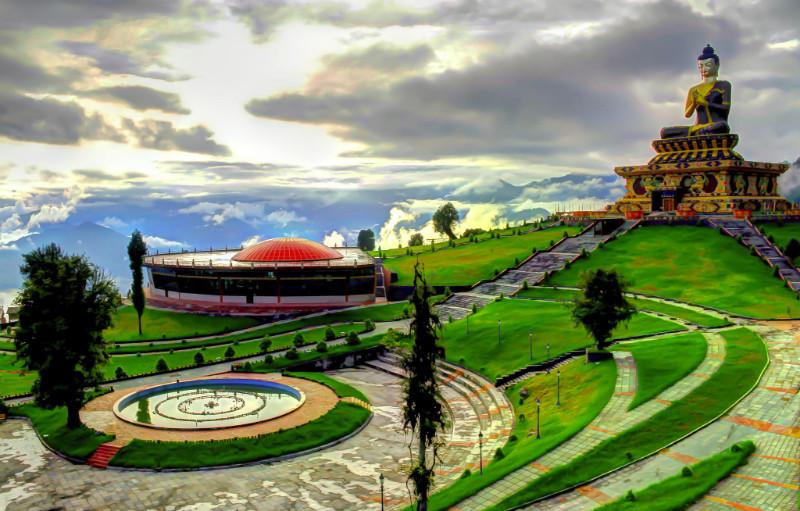
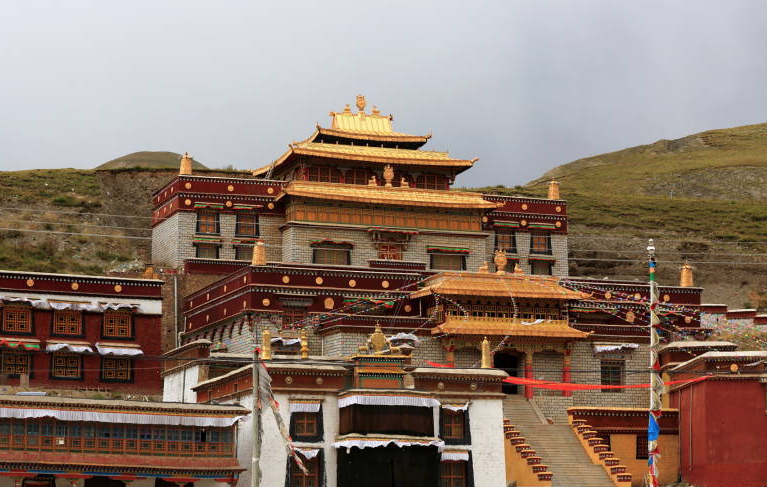
About 6 km away from central Ravangla towards Legship is the small but very interesting monastery known as YungdrungKundrakling, the only Bon monastery in Sikkim. Bon was an animistic religion that pre-dated Buddhism in Tibet, but has since been largely incorporated into the latter. Nevertheless, there are interesting distinctions in the sculptures and architectural style; for instance , the deities look slightly different and the orayer wheels here are turned anti-clockwise.
Borong and Ralong Hot Springs are natural hot springs that are said to have curative powers and is popular with many visitors to this region. Ralang Cha-chu is an hour’s walk away from the RalangGompa, while Borang Cha-chu is 7 km away from Ralong, followed by an hour’s walk downhill. Both these hot springs are located along the banks of River Rangit and can be visited from December to February.
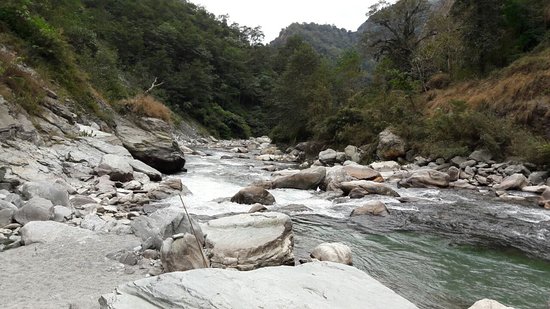
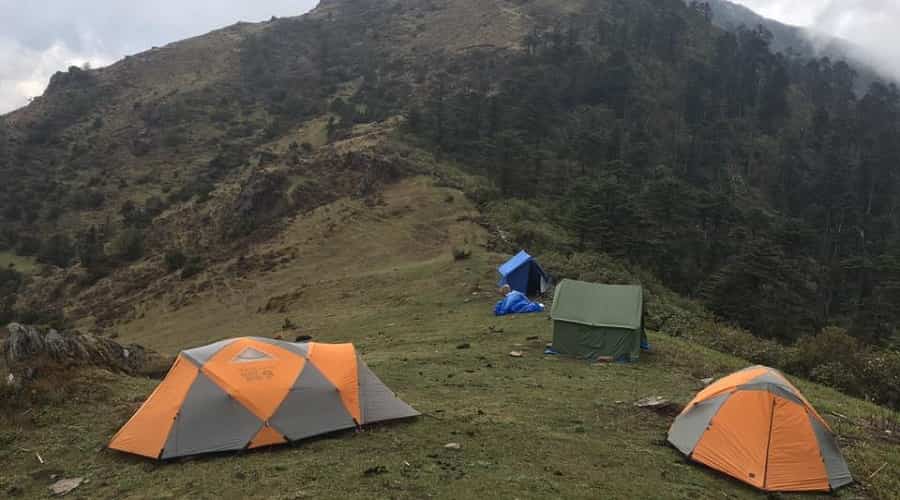
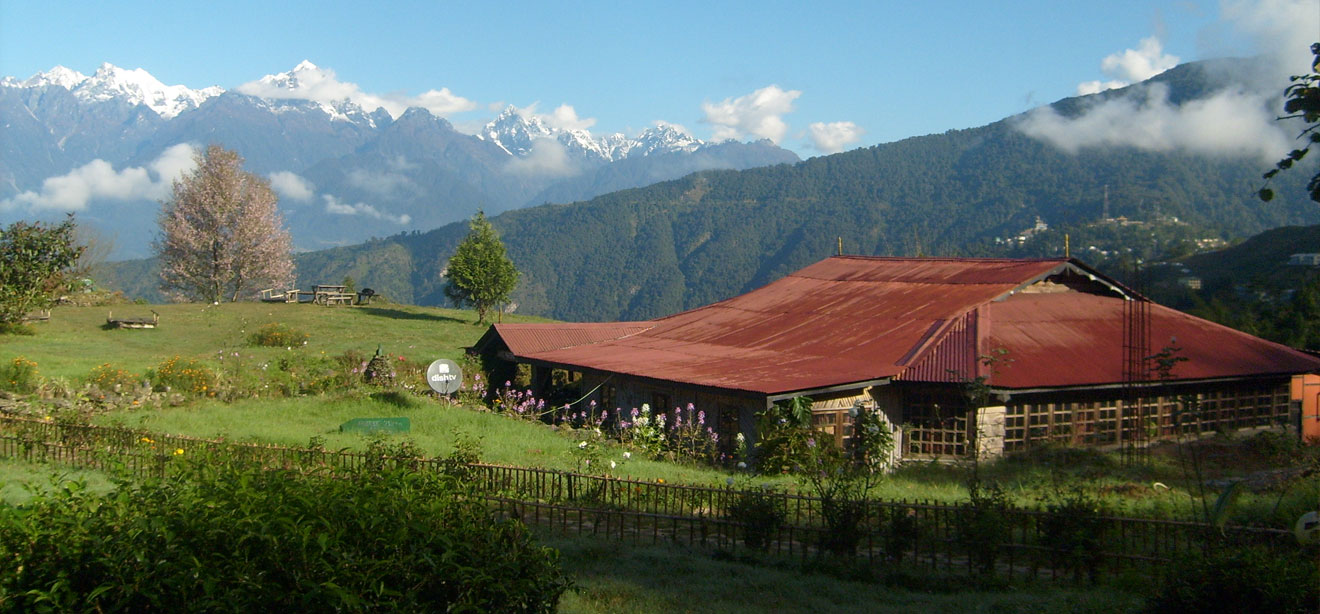
Damthang( 1650m ) is one hour away from Ravangla, and might be combined with the Maenam hike above. Opt to stay at Ravangla and plan your hike so you are back in time, since there are no appropriate accommodation options in Damthang.
Above Damthang, overlooking the South District headquarters of Namchi, there is asmall flat stretch of land at an altitude of 2600 m. It is surrounded by an ancient forest, and is known as Tendong Hill—this hill is dormant volcano. According to folklore, the hill saved the Lepcha tribe from the ravages of the deluge when the whole world was flooded, reminiscent of the story in the Old Testament. Lepchas continue to pay homage to the hill.
Follow the main road from Damthang, heading northeast, and then take the trial via the forests of the Tendong Sanctuary. The view from the top simply stunning, spanning the plains of Bengal up to the heights of the Himalayan ranges.
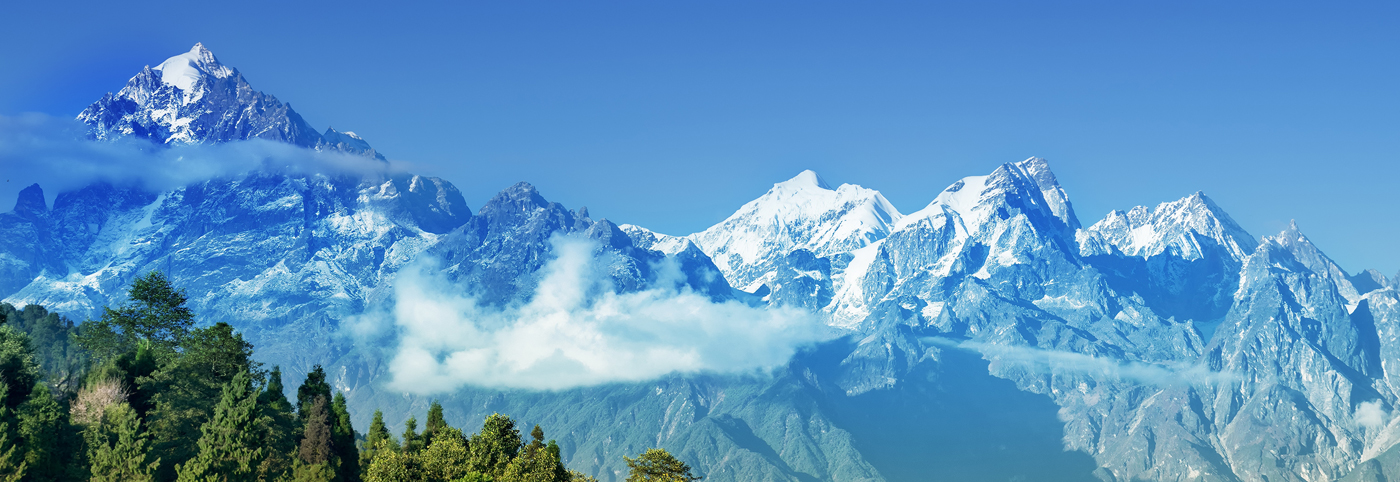
Pelling , a small hamlet in West Sikkim till a few decades ago, is quickly developing into a popular hill station. The town stands on top of a ridge and is divided into upper, middle and lower areas. In Pelling , you can take lovely mountain walks, enjoy the cool breeze and catch stupendous view of the Khangchendzonga mountain.
You can visit the famous Pemayangtse Monastery as well as Sangachoeling, the second-oldest gompa in Sikkim. The ruins of the erstwhile capital of Sikkim at Rabdentse, restored by the ASI, are not to be missed.
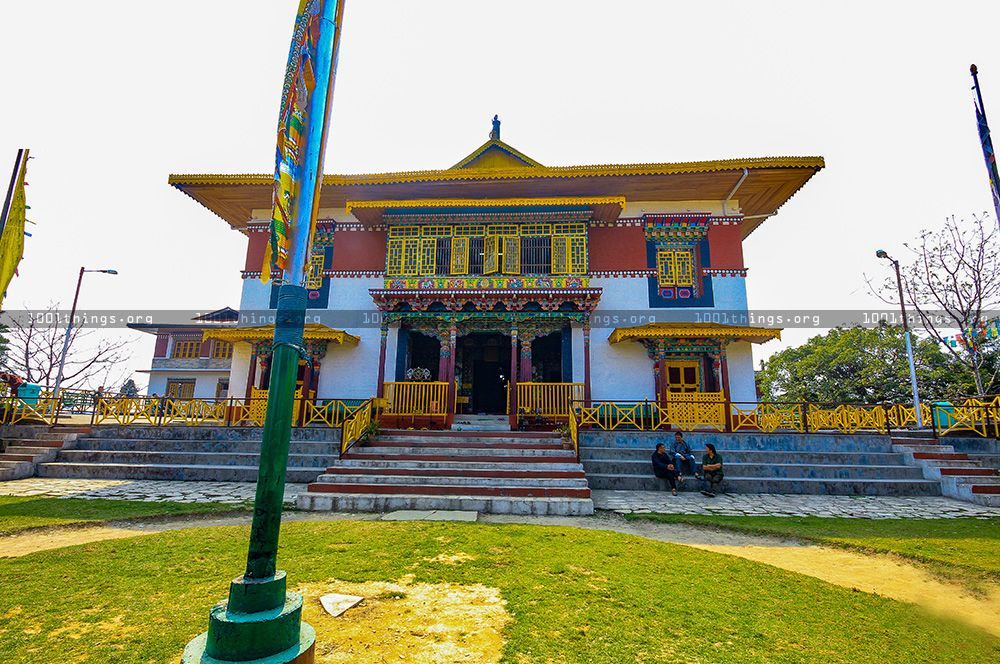
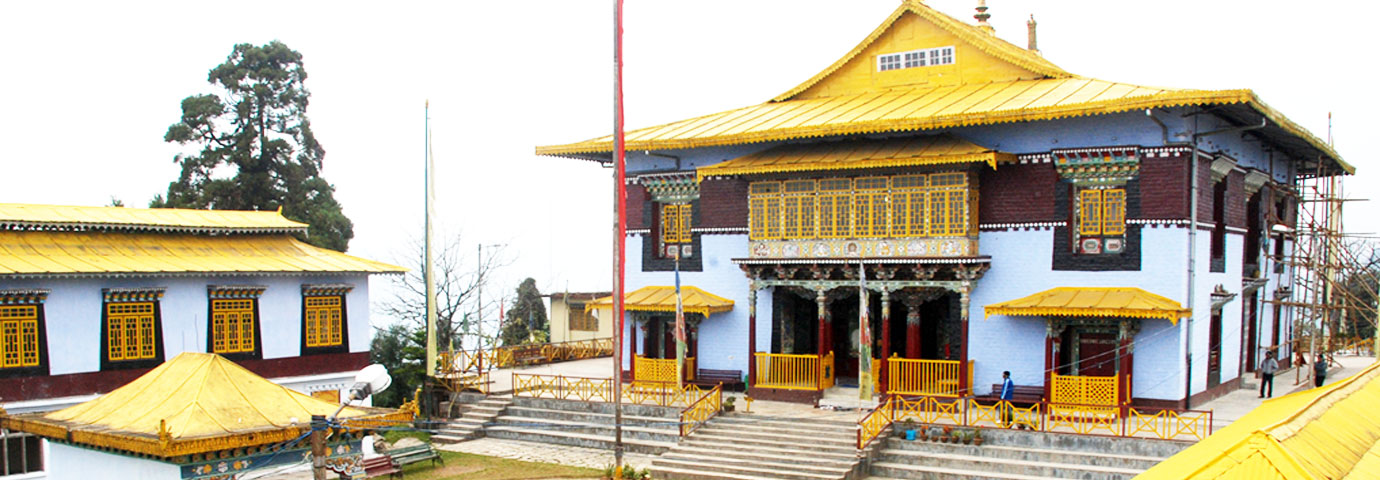
Located half km outside of town , this is the third-oldest monastery in Sikkim, established in 1705 CE. Its name is derived from “ padma yang tse “ literally translating to ‘ the sublime perfect lotus’. The monastery was built after the legendary LhatsunChennpo had introduced Lamaism in Sikkim in the 17th century.
Legend has it that Lhatsun flew over the 24000ft high Mount Karbu when he could find no overland route from Tibet to Sikkim. Upon reaching Yuksom, he helped in the coronation of the first king of Sikkim and founded the first-ever monastery in Sikkim at Dubdi. Pemayangtse is said to have been designed by Lhatsun for the use of the ‘ ta-sang’ , or ‘pure monks’ , of Tibetan origin.
But what really links the monastery to the lama is the extraordinary Sangtok-Palri, a three-dimensional wooden model of a celestial city which came to Lhatsun in a vision. The size of a large dollhouse, containing no nails and put together only with wooden joints, the model represents a beautifully burnished and lacquered celestial city , teeming with palaces and pleasure domes, gardens and pavilions.
The monastery has an atmospheric compound with gardens and cottages inhabited by the resident monks. On the ground floor is a central Buddha image, and upstairs are formidable statue depicting the eight incarnations of Padmasambhava.
Located 3 km outside of Pelling, the Rabdentse, the ruins of the second capital of Sikkim from 1670 to 1814, established by Sikkim’s second king, TensungNamgyal.
Rabdentse is a bit of a puzzle. Of all the buildings in the capital, only the ruins of the place exist, if you discount the nearby Pemayangtse. The ruins are perched on top of a hill and are divided into two distinct sections. The large one is almost certainly the palace complex and the other probably a more public place, a paved courtyard meant for the king’s subjects. Standing in the courtyard , you have a wide-angle view of the mountains. The ruins themselves are ten minutes walking from the site’s gate.
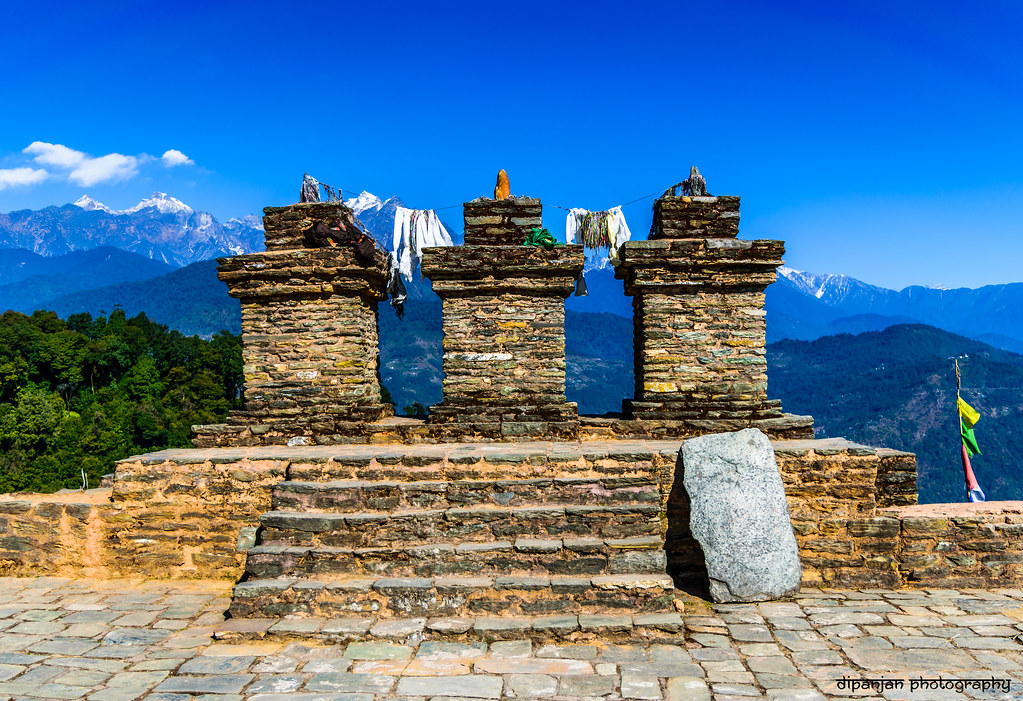
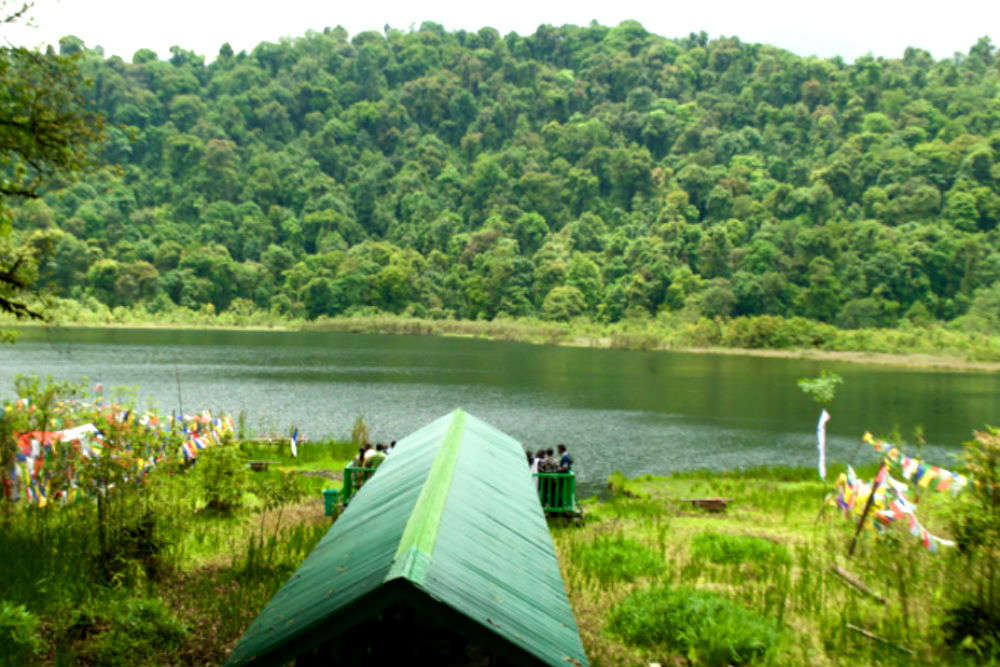
Located 31km from Pelling , this serene natural reservoir stands at a height of 6400 ft and holds an important position in the lives of Sikkimese Buddhists as well as Lepcha animists, the latter believing that the lake’s shape is similar to the footprint of the goddess Tara. The surface of the lake is unusually clean, and some say that it is because birds dutifully remove leaves from its surface. The lake is also said to have been originally known as Kha-Chot-Palri, meaning the heaven of Padmasambhava.
A visual treat awaits those who visit the lake during the annual KhecheopalriMela, held in the months of either March or April. The distinguishing sight of the fair is butter lamps floating across the lake, while colourful Tibetan prayers flags flutter all around.
This is located about 15 km away from Pelling on the way to Yoksum. The water is icy cold falling down the granite rocks that surround the area. The midst of water drops from the water all the suspended in the air and this can make your clothes cold and moist.
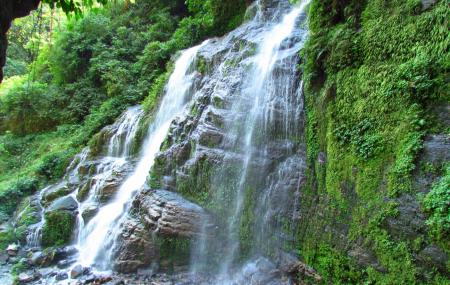
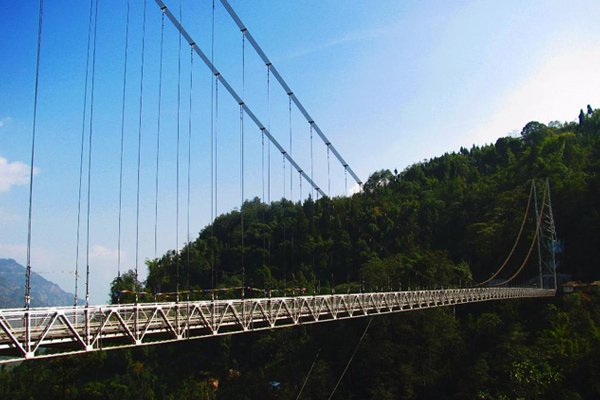
25 km from Pelling and about 5 km ahead of Dentam towards Uttaray is the suspension bridge, which is build over a gorge that is about a thousand feet deep. The engineers that built this bridge really took pain and trouble to construct it. This is the second highest ( from the Gorge) bridge in Asia.
This little village is an hour’s drive from Pelling, or five hour’s up from Siliguri. Two km ahead of the village is the beautiful 44 acre Yangsum Farm.
On a clear day, you get great views of majestic Khangchendzonga. Two 18th- century monasteries are short walks away , one of which is the ResumGompa, built by a powerful local landlord, with an impossibly felicitous settings at the meeting point of three hills – Kaluk, Rinchenpong and JhilHatidhunga. The famous “ PoisonPokri” or the poisoned lake, is a must –visit. It is said that the Lepchaspoisoned this lake, the only water source at the time, to spot the invading British forces; they were successful, though the lake remains poisoned to this day.
You can also opt for relaxed strolls past village homes and the local school. The area is also excellent for birding. Take unhurried walks, watch ducks and geese amble on the makeshift lawn and simply relax.
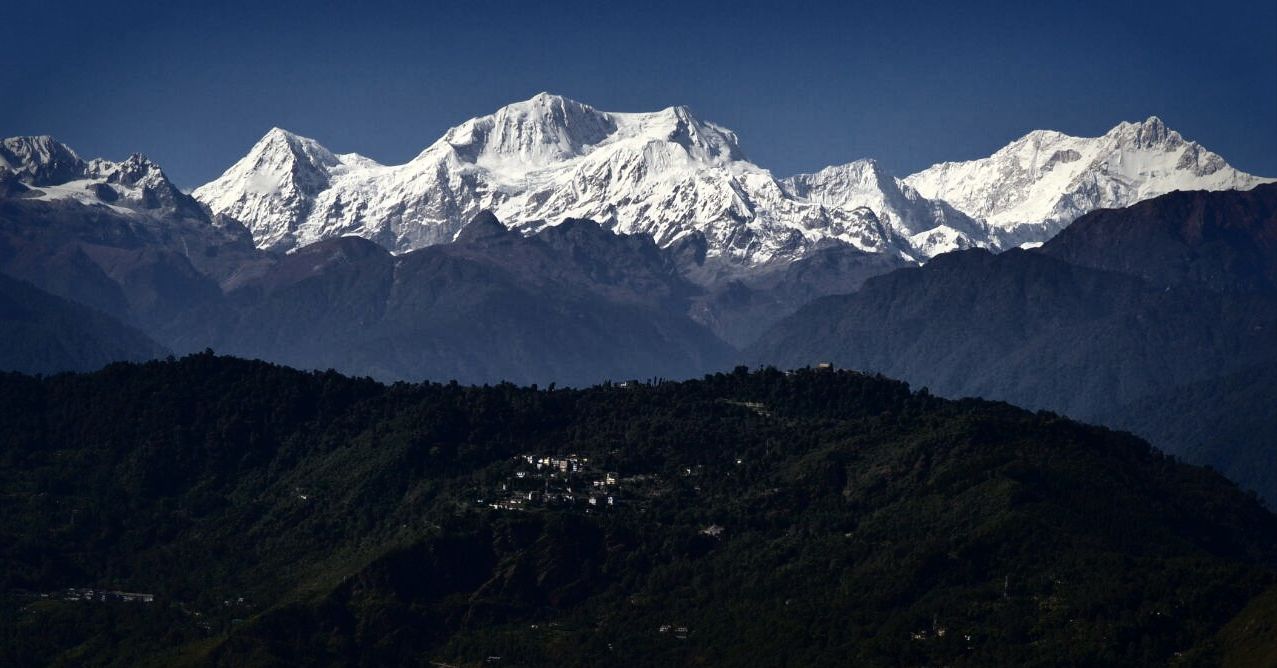

Delightful Darjeeling, the world famous hill resort, also referred as the “ Queen of the Himalayas “ is perched at an altitude of 2134 m, about 686 kms by road from Kolkata. The name Darjeeling originates from the Tibetan word “ dorje ling “ or “ Place of the Thunderbolt “. It is endowed with exceptional scenic beauty and offers a magnificent view of the grandeur and beauty of the mighty Himalayas. The beautiful town is indeed a paradise for holiday and adventure seekers as well as botanists , ornithologists, photographers and artists. The lovely lush woods around Darjeeling are full of conifers like fir, pine and birch and are known for exotic orchids, about 4000 varieties of flowering plants and 300 types of ferns, including the rare tree fern. The jungles are also home to rich animal and bird-life. Darjeeling has emerged as a perfect base for adventure sports like trekking, rock-climbing, mountain biking, water rafting, canoeing, paragliding etc.
The name Darjeeling is also synonymous with the most exquisite tea of the world. The aroma and delicacy of the tea produced here is unmatched and is also called as the “ Champagne of the East “. The best time to visit this enchanting land is from March to Mid June and September to Mid December.
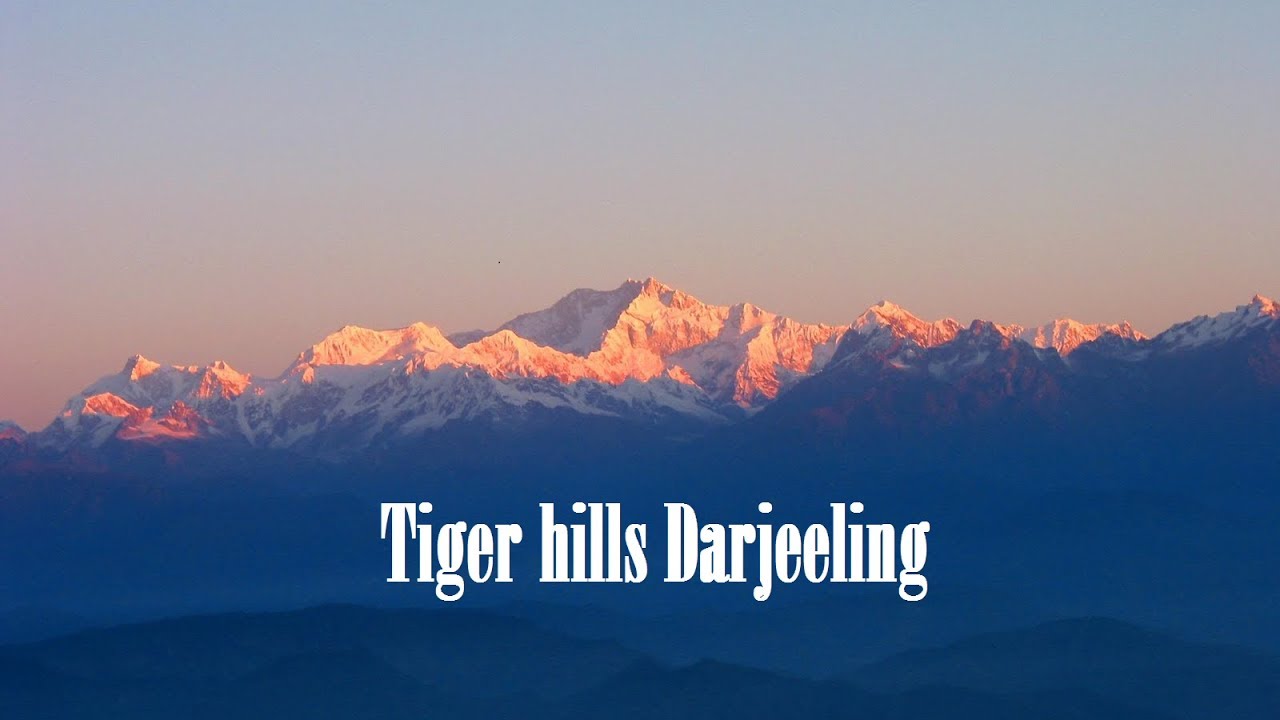
This 2585m, high hill lies 13 km from Darjeeling and is regarded as the best place to view the Kanchenzunga range, especially at sunrise. A viewing tower here provides an awe-inspiring view of the majestic Eastern Himalayas. Passing through primitive forests of Oak, Magnolia etc with beautiful ferns ablaze with colour ,adoring the hill-sides , is the steeply ascending road to Senchal, running through Ghoom on its way to Tiger Hill. From the summit, to the north, lies the town of Darjeeling and in the and in the back ground stands the stupendous snowy range in all its glorious magnificence. No finer place exists to steep the viewer in the grandeur and beauty of towering snowcapped mountains. Mt. Everest ,225 km away rarely deigns to come out of the cloudy mists, with its two other peaks Makalu ( 27769 ft ) and another peak on both sides about 135 km away in Tibet’s ChomolHari mountain, said to be the world’s most beautiful peak.
Aboard the ‘ toy train ‘ from Siliguri to Darjeeling just below Ghoom and 5 km from Darjeeling is the Batasia Loop, an engineering marvel and feat. Almost imperceptibly, the railway line negotiates a circle and descends 1000 ft in altitude. The train’s figure 8s and Z maneuvers areas picturesque as the flowers, streams and water-falls. At Batasia-windy place one gets a grand view of the town of Darjeeling perched on the slopes of hills and Kanchenjunga in the background.
The war memorial constructed in the memory of brave sons of Darjeeling who died in different action since 1947, is worth a visit. A glorious view of snowy peak and town can be seen from this place.
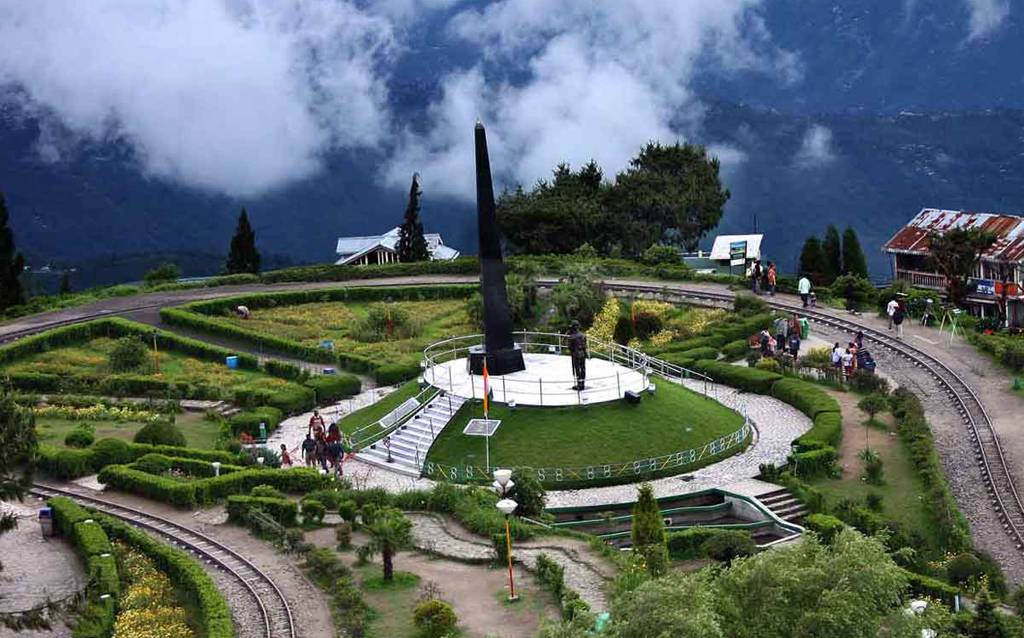
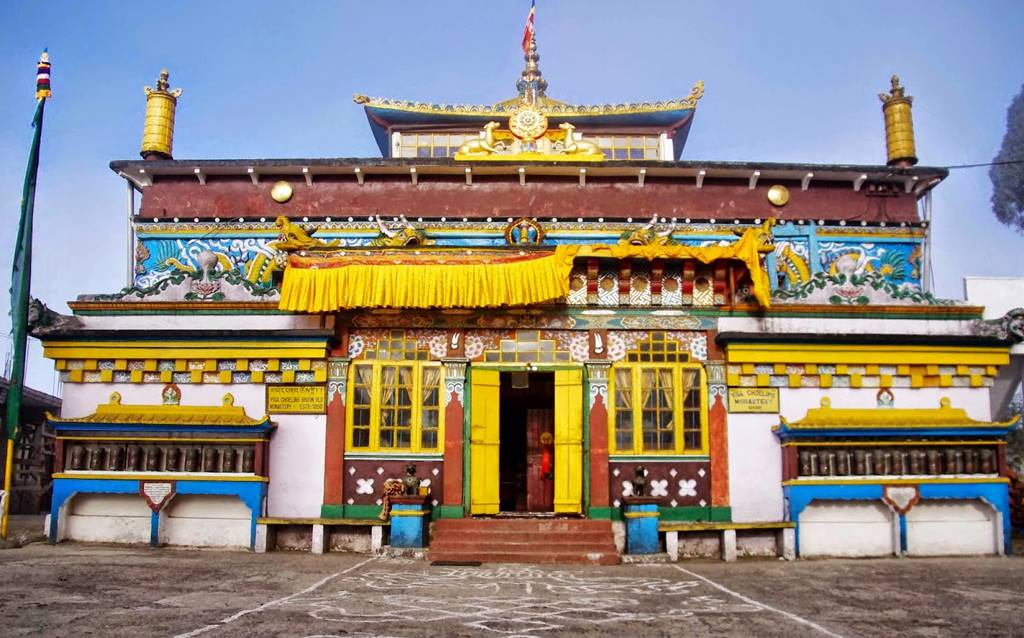
It is the last town on the Indo-Nepal border and has the distinction of having the railway station at highest altitude in the country. The famous Tibetan Buddhist Monastery here enshrines a 4.8m statue of the Maitreya Buddha ( the coming Buddha ). The monastery is well known for its Tibetan new Year celebrations during Feb-March. The 30.5 m high Ghoom Rock affords a panoramic view of the surroundings.
It is located on Jawahar Parbat, 2km west of the Mall and is the first mountaineering training centre of the country. The Himalayan Mountaineering Institute here depicts history of mountaineering, while the Everest Museum displays memorabilia of the 1953 Everest expedition of Tenzing and Hillary. The huge ‘ Hitler’s Telescope’ here provides a fine view of Kanchenjunga.
Tenzing Rock and Gombu Rock: These are located at Lebong Cart road. Rock climbing lessons are imparted here by the HMI
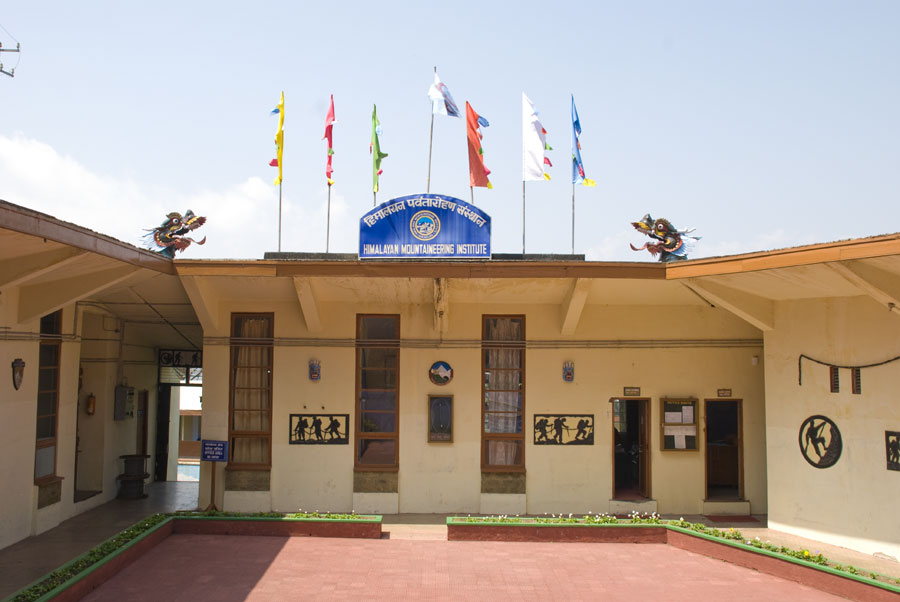
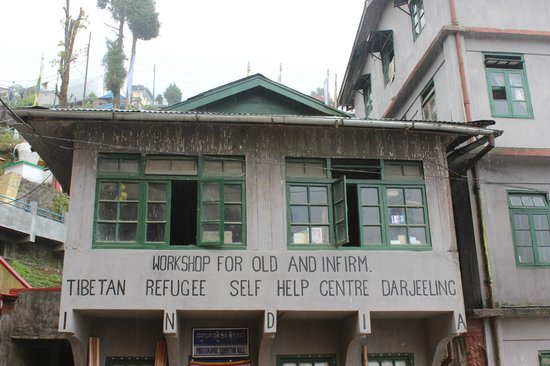
It is established in 1959, to rehabilitate the Tibetan refugees. Excellent carpets, woolen goods, wood work etc are produced here.
Darjeeling region is dotted with tea gardens, which produce world’s most expensive and exotically flavored tea. This tea estate is just 3 kms from the town and is a must visit site. Here one can also see the ‘Orthodox Tea Manufacture’ method of tea processing.
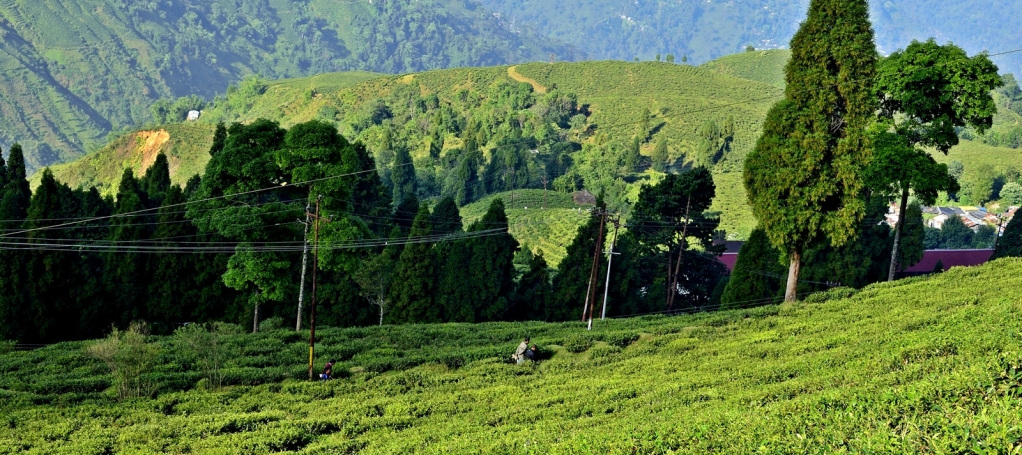
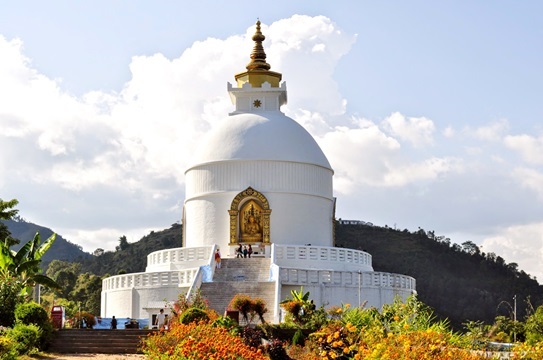
It is inaugurated in 1993 and affords an excellent view of the town and Majestic Mountains. On the way in ofLalkothi, the DGHC House, which can be viewed from outside.
There are two ropeway systems at Darjeeling. The first one is 1408m long, connecting Darjeeling with Bijanbari at the little Rangeet Valley. The second one is a bi-cable passenger ropeway that connects Darjeeling’s North Point and Singla, covering an aerial distance of 8 kms. It is the first bi-cable passenger-carrying ropeway in India and the longest of its kind in Asia.
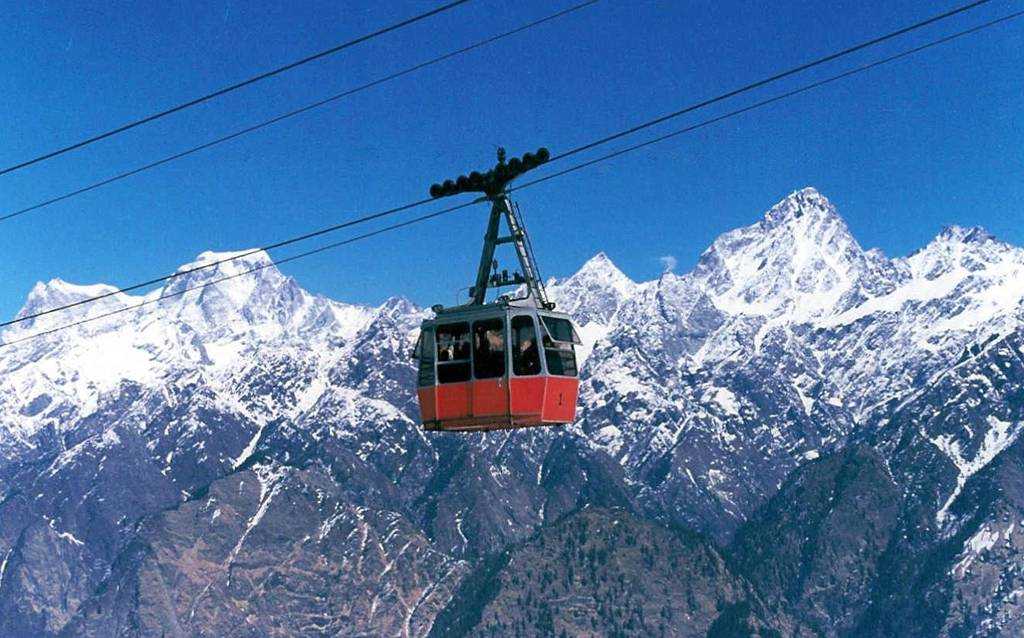

It is located near the HMI and is home to some rare Himalayan fauna like snow leopard, Yak, Siberian Tiger, Himalayan black bear, red panda, Tibetan wolf, Himalayan pheasant etc.
This well laid out terraced garden lies just below the market motor stand. It has an excellent collection of plant specimens from the sub-temperate and temperate Himalayas. There is also a representative collection of plants from all over the world. The Orchidarium here has over 2500 plants. An excellent flower show is held annually during the summer months.
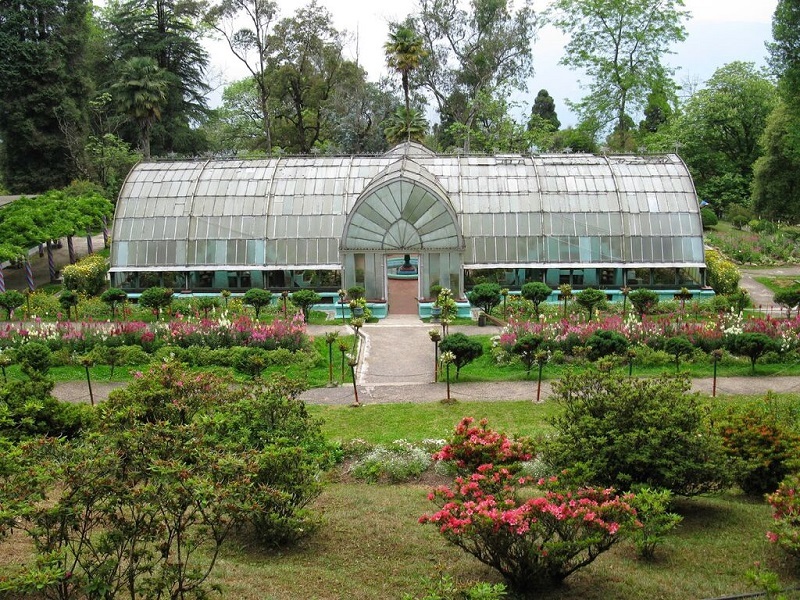
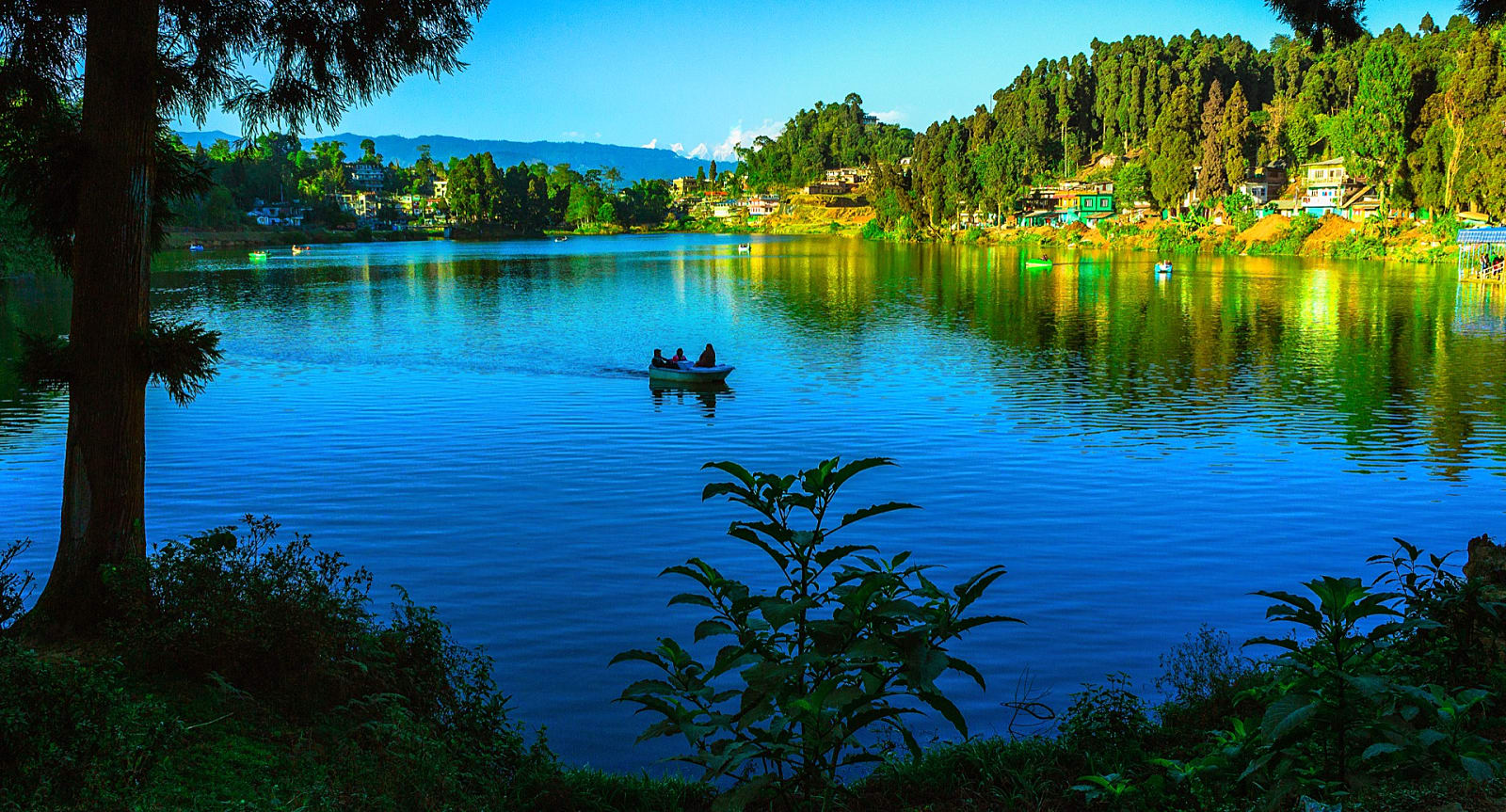
It is surrounded by tea estates, orange orchards, cardamom plantations and lush woods full of oak, maple and chestnut trees. The main attraction of this beautiful place is the 1.25 kms long Sumendulake at the bottom of the Mirik Spur. Boating and angling facilities are available.

Kalimpong is a quiet picturesque hill station in the Lesser Himalaya, located at an altitude of 1200m and at a distance of 50 km to the East of Darjeeling. It was once the hub of the trans-Himalayan trade between India and Tibet-Merchants used to ferry goods by mule caravans over Jelepla Pass on the Sikkim-Tibet border.
The name of this town has historic significance. Kalimpong was once the headquarters of a Bhutanese Governor. The word “ Kalim” means “the King’s minister” and the word “pong” means “Stronghold”, hence “ Kalimpong” means “ the stronghold of the King’s minister”.
The dense forests of golden oak trees that are offset by the rich undergrowth of moss and lichen are an ideal setting for balmy walks on the thick cushions of russet leaves. One comes to Kalimpong to slow down and be pampered amidst nature’s bounties.
The monasteries of Kalimpong dating back to 1836 tell a rich story not only of past events but also of local art and culture. You could visit the Pedong, Thongsa and TharpaCholing monasteries here, amongst others. Meeting the little monks and gyalong-blowing lamas will transport you to a different world of experience that will be your tryst with eternity.
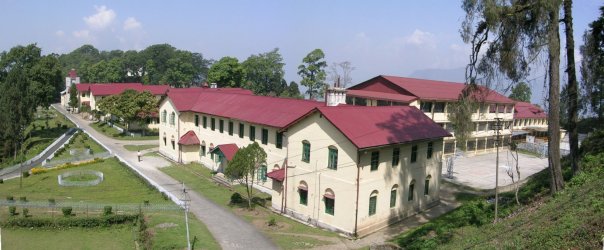
It was founded in 1900 by Dr.J.A Graham, a Scottish missionary. This Institution was established as an orphanage-cum-school for destitute Anglo-Indian children . It is now a renowned regular co-educational school situated in a 500 acre campus.
It is the highest point within Kalimpong municipality area which provides 360 degree panoramic view.
